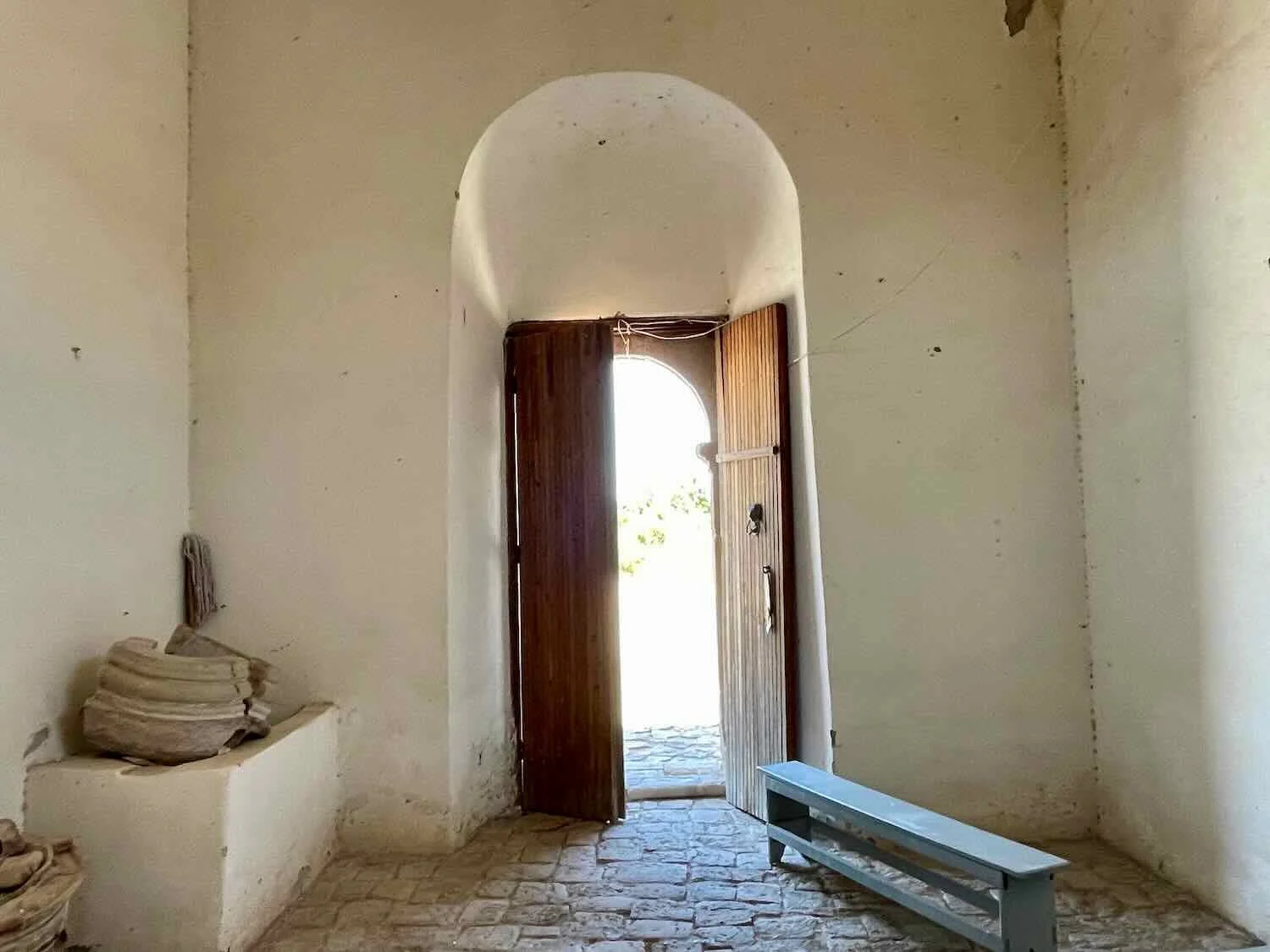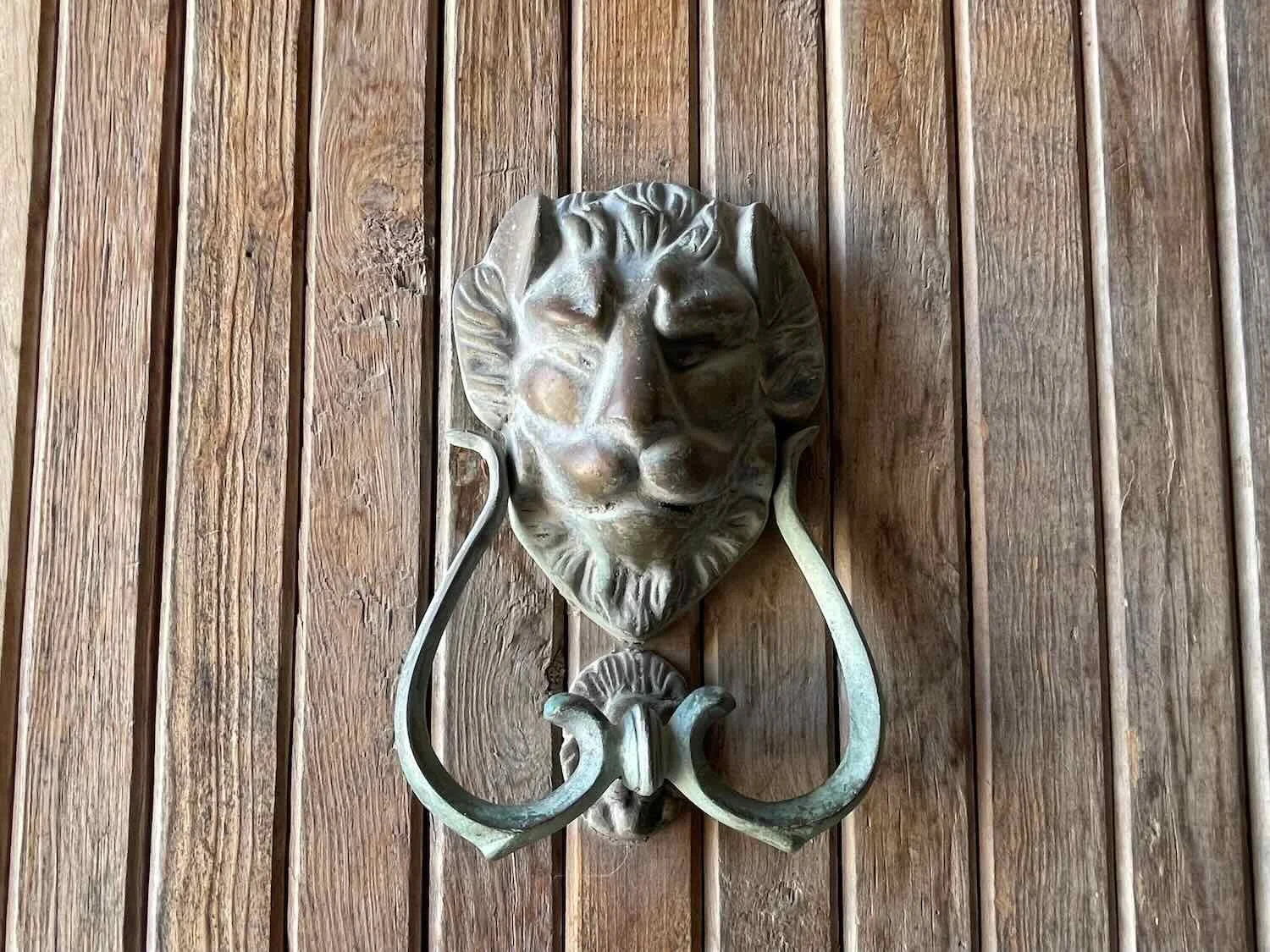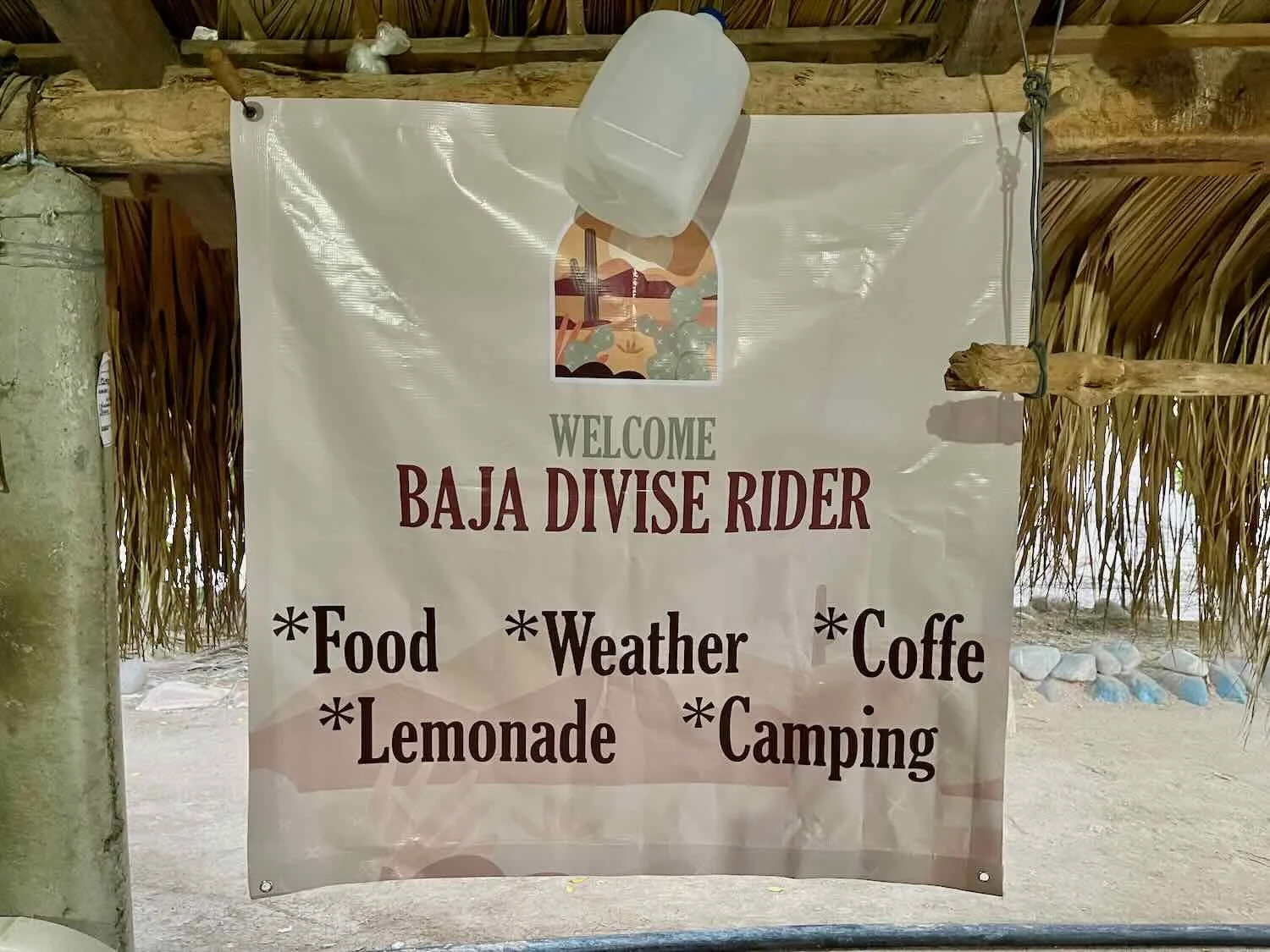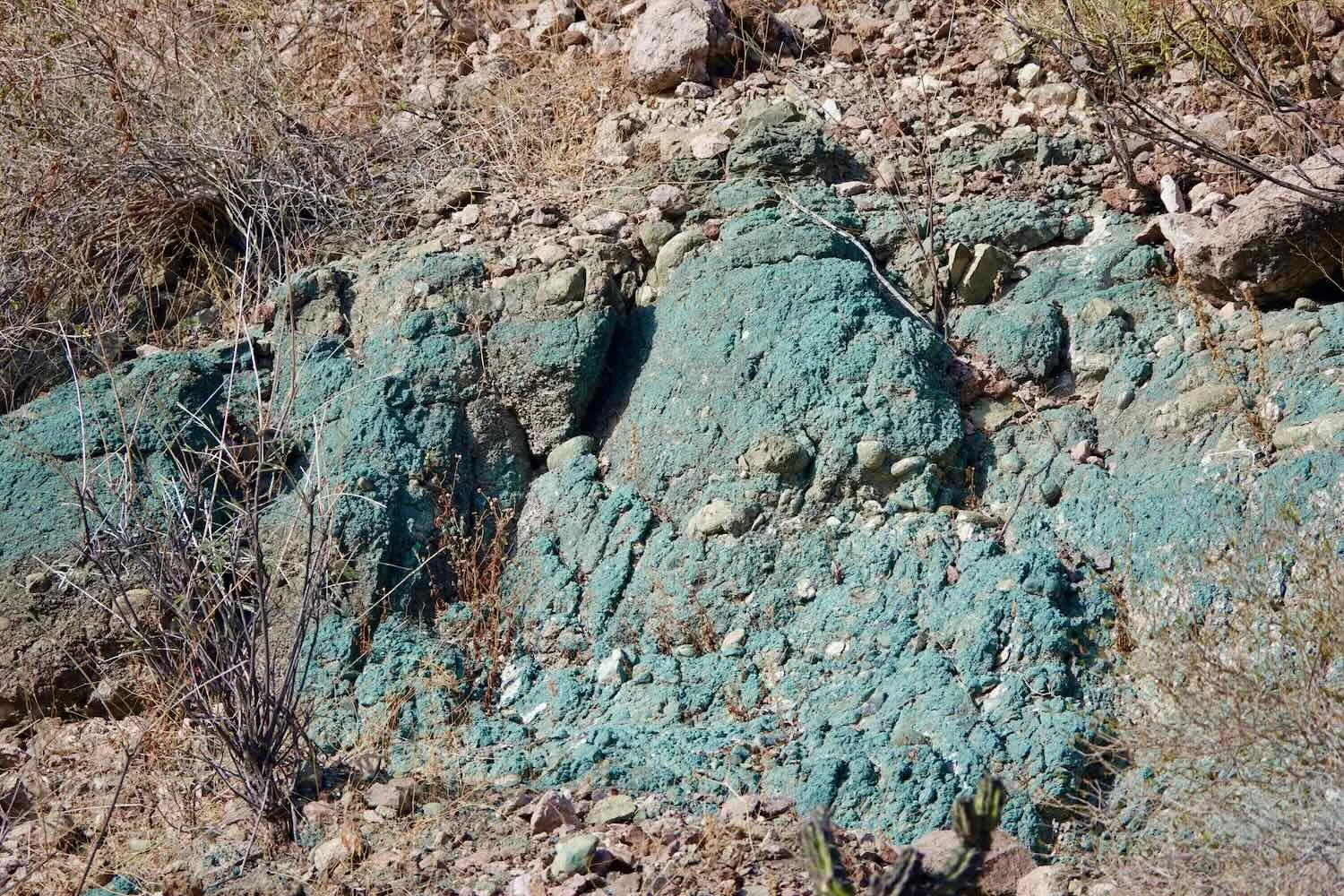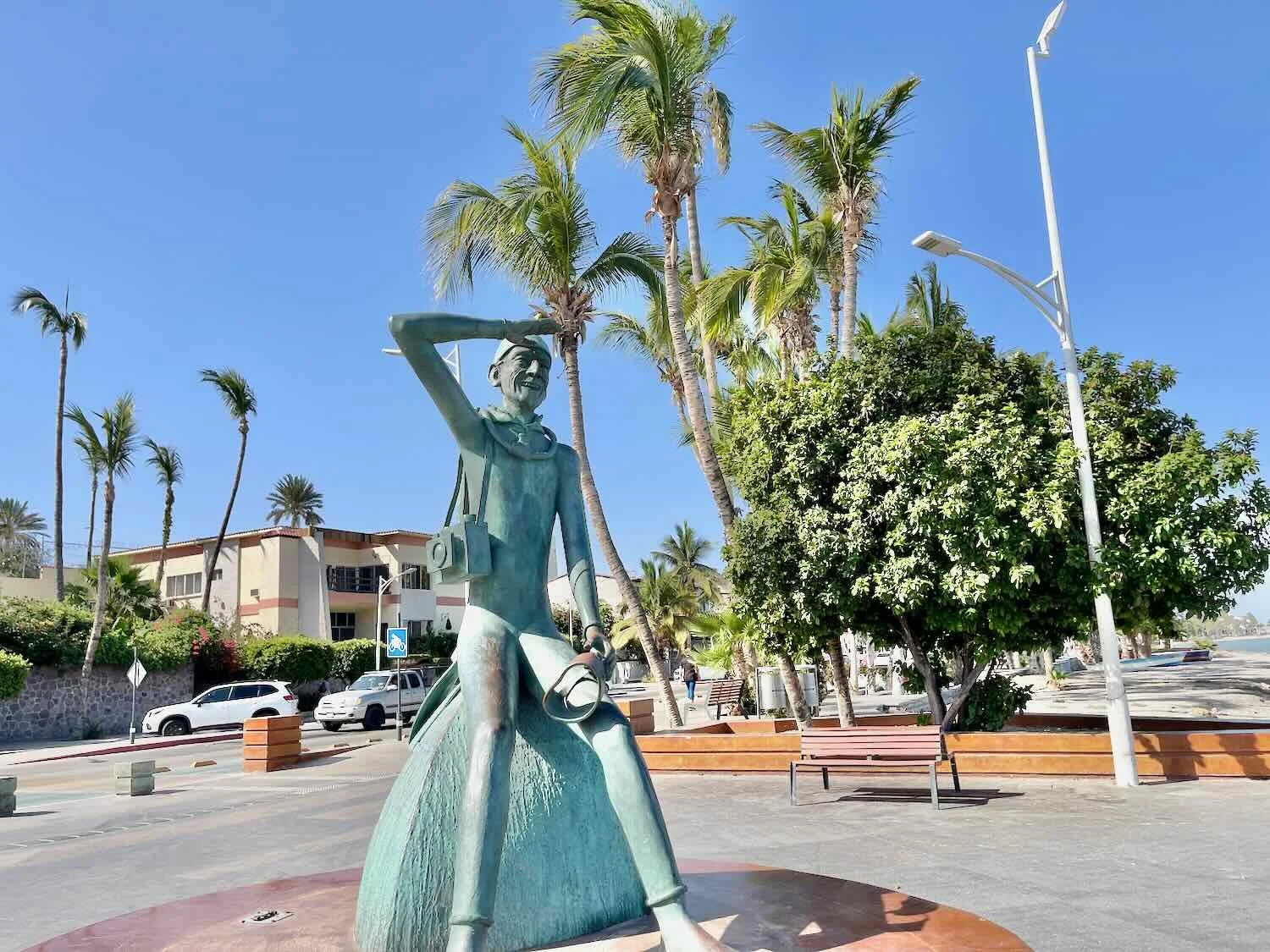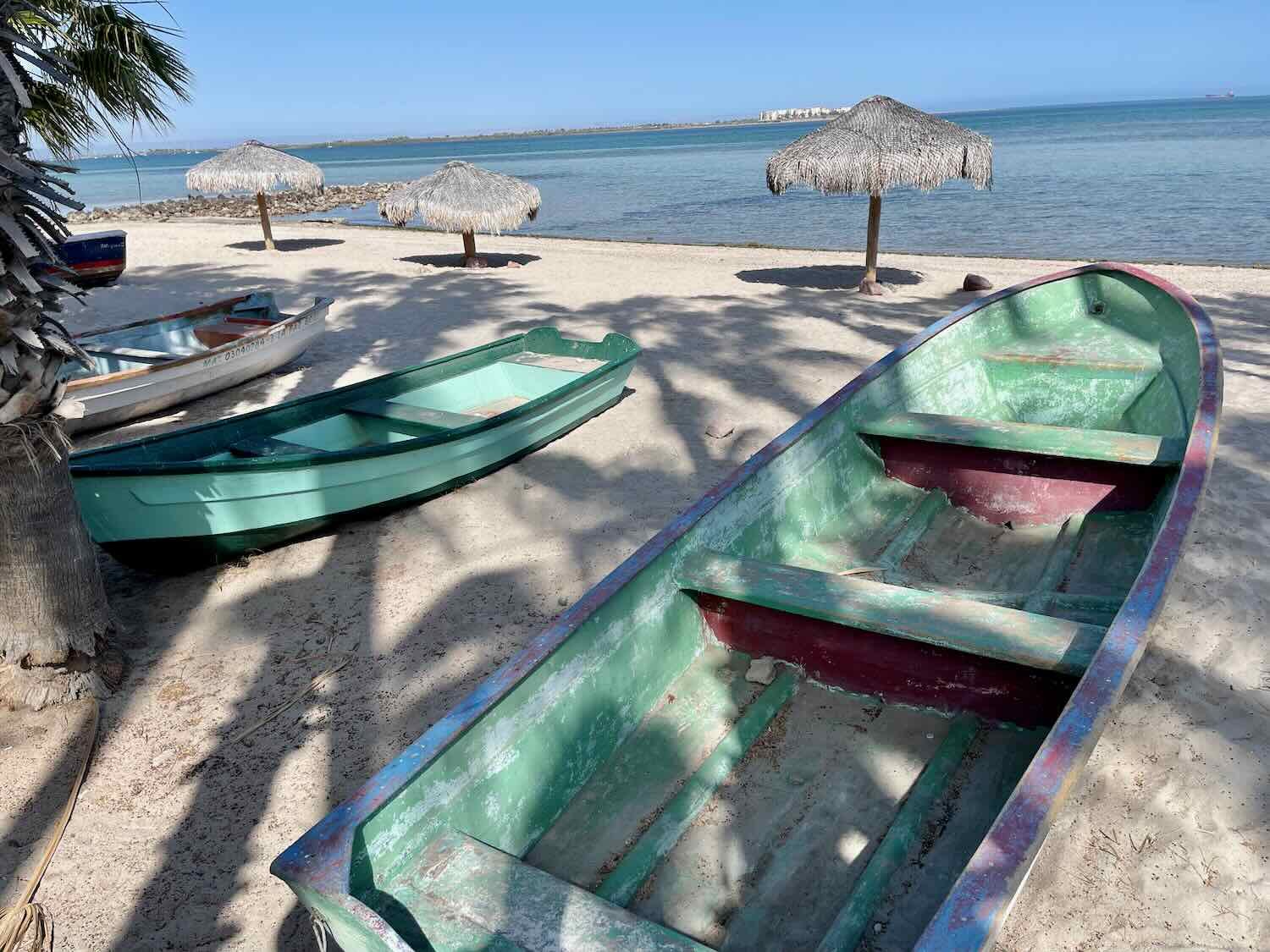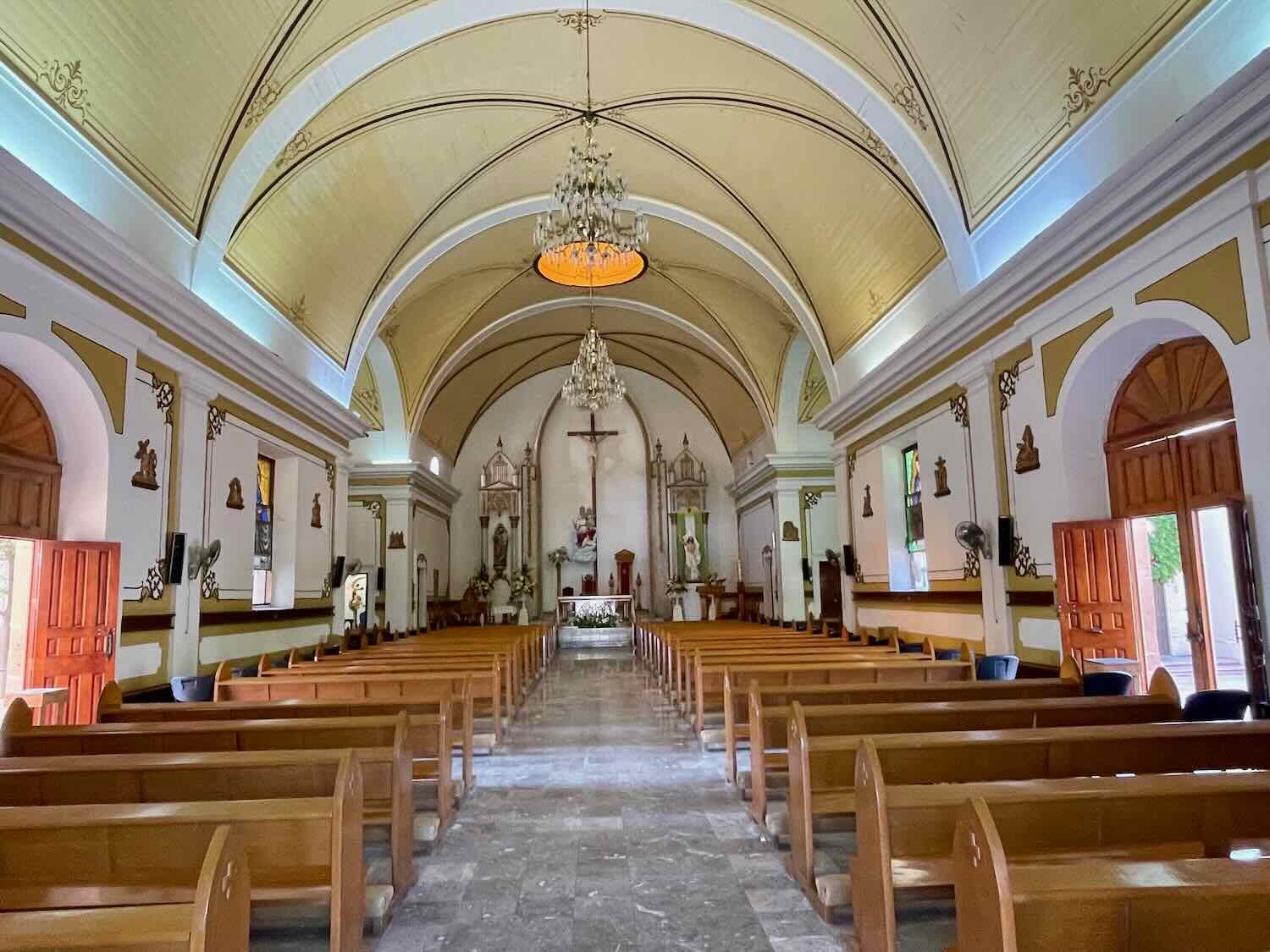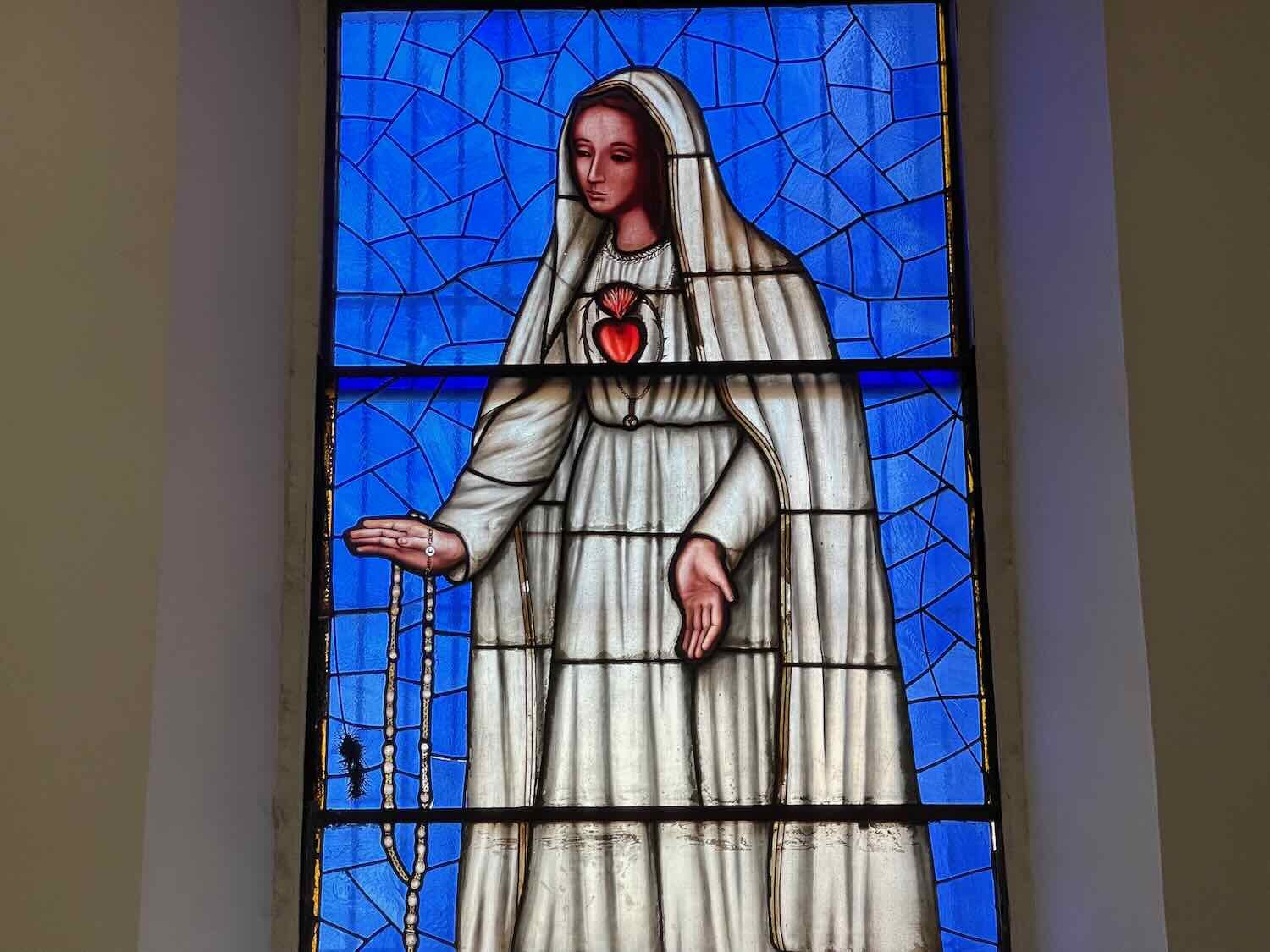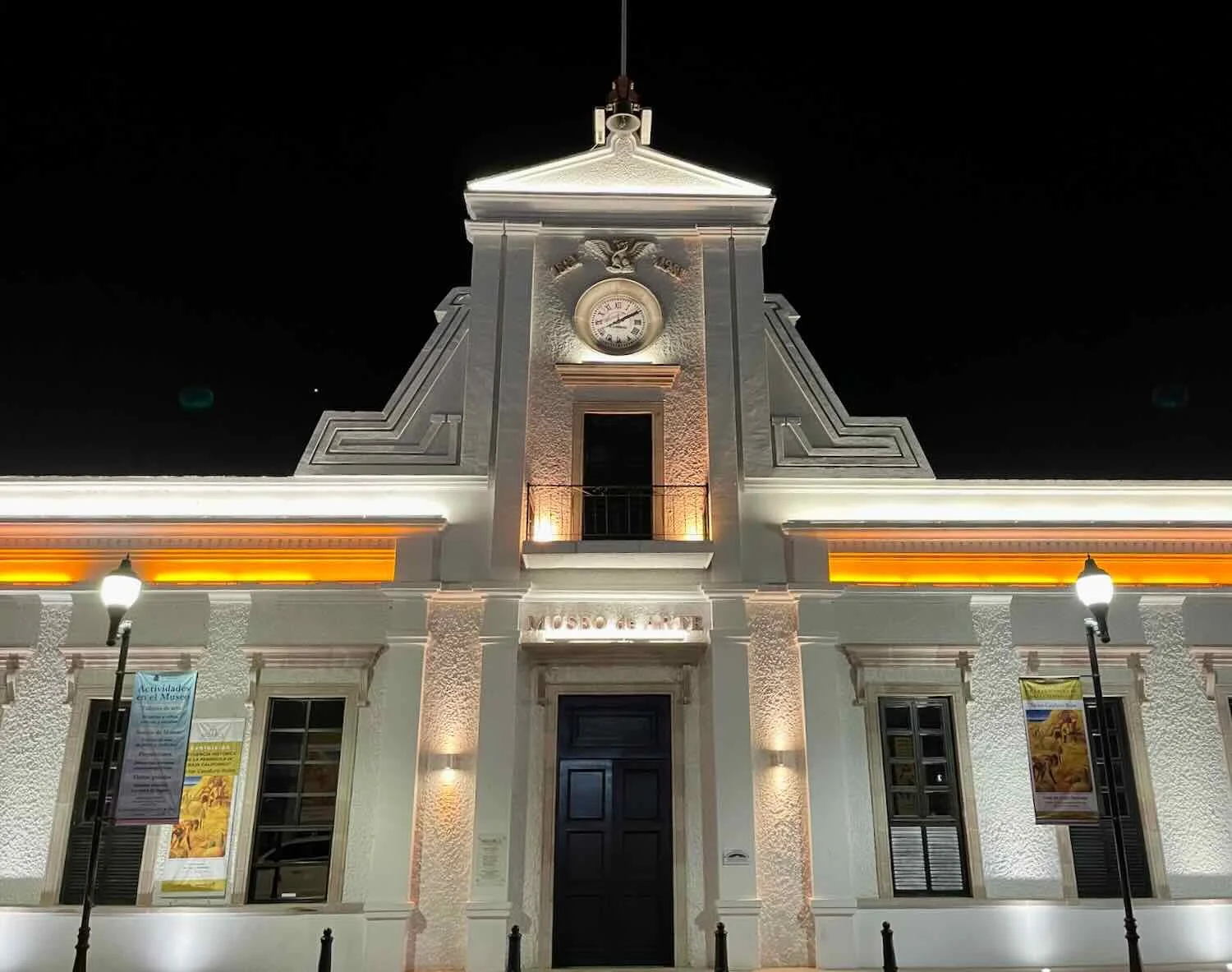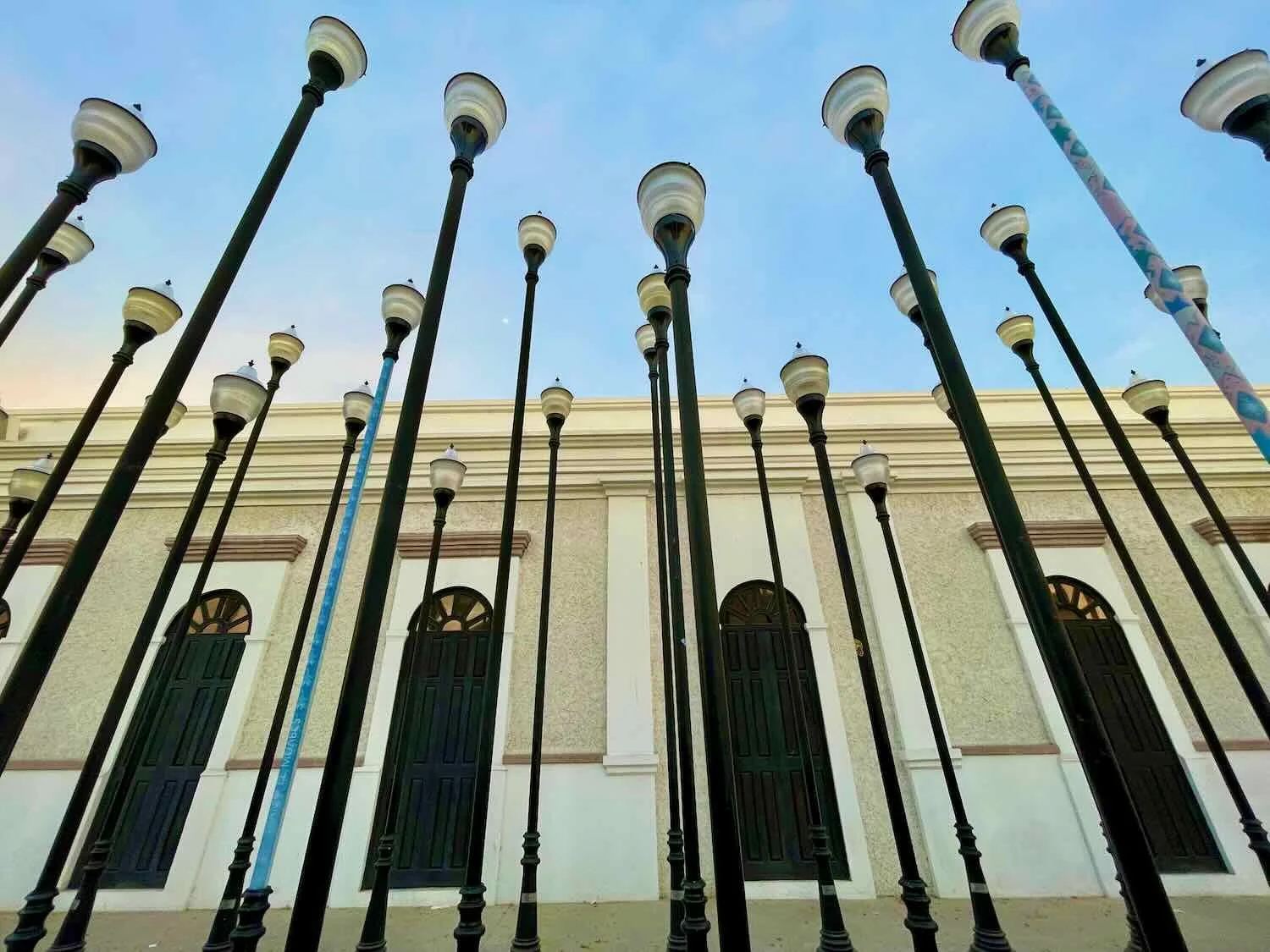Baja Divide Part 6: Cycling from Ciudad Constitución to La Paz
14 - 22 April 2023
Baja Divide Section #16
14 April - Ciudad Constitución to Wild Camp East of San Luis Gonzaga (41.0 mi, 66.0 km)
15 April - Wild Camp East of San Luis Gonzaga to Las Ánimas (26.5 mi, 42.6 km)
16 April - Las Ánimas to Wild Camp East of La Soledad (14.4 mi, 23.2 km)
17 April - Wild Camp East of La Soledad to San Evaristo (9.8 mi, 15.8 km)
18 April - Layover in San Evaristo
19 April - San Evaristo to Wild Camp on Secluded Beach (34.0 mi, 54.7 km)
20 April - Wild Camp on Secluded Beach to Chametla (45.3 mi, 73.0 km)
1 May - Chametla to La Paz (6.8 mi, 11.0 km)
Another Mission in the Hills
After Easter, we finally pulled ourselves away from Ciudad Constitución, and headed back out on the Baja Divide. Once again we were impressed by the sheer size of the city’s footprint. We biked to the southern edge of town, then took a left on a road towards an airport. Along that road, the urban area extended for another 3+ miles (5+ km) away from Hwy 1. Most other towns in Baja have been one-road towns, with most businesses located along the main road through town, and relatively few streets extending away from it.
At the far edge of town we turned onto a dirt road that infamously runs through the city dump. We had heard about this, so it didn’t come as a surprise. But it was still pretty unpleasant. For 2-3 miles (3-5 km) the dirt road was littered with trash, including enough sharp, pointy objects that we had to watch carefully where we steered our bikes. There also was a section where the trash was burning and we had to cycle through the acrid smoke, which didn’t seem particularly healthy. The fact that the road through the dump was covered with deep washboards didn’t help - it slowed us down and prolonged the unpleasantness. At one point we encountered a very large junkyard dog - perhaps the largest dog we had seen in Mexico. Fortunately, it seemed more afraid of us than we were of it.
This sign reads, “It’s prohibited to dump trash in this area.” Hmmm. Ciudad Constitución city dump, Baja California Sur, Mexico. Copyright © 2019-2023 Pedals and Puffins.
Finally, after about 20 minutes, we left the city dump behind. But even then the landscape was not that appealing. For some reason, all of the vegetation for many miles was dry and brown - much more so than in the other places we had cycled in Baja. There were no leaves on the palo verde trees or the ocotillos. We did spot one new and interesting plant, though. It was a skinny, yellowish-green, agave that we hadn’t seen before. We later learned that it’s called Datilillo, and that it’s only found in the southern part of the Baja Peninsula. That was pretty cool.
Datilillo (Agave datylio) only grows in the southern part of the Baja Peninsula. It was pretty common along our route after leaving Ciudad Constitución. Baja California Sur, Mexico. Copyright © 2019-2023 Pedals and Puffins.
After four hours of cycling we climbed a short, steep slope up onto the top of a long, straight, high berm that looked very much like it should be a dam. It stretched across a low area in the valley for at least a half mile, maybe more, and seemed to be well over 50 ft high (15+ m). The structure looked like it was meant to create a really big reservoir. We saw a few great egrets flying around, which made us think that there must be water somewhere, even though we couldn’t see any from the road. We were in intrigued, so we decided to ride out on the top of the dam and investigate.
There was, in fact, a very small pool of water far below. But most of the land that seemed like it should have been underwater was covered with trees, or was actually being farmed. There were sheep, cows and horses. Plus, a guy was out in a tractor plowing a field. We definitely got the impression that the dam didn’t work out as planned.
A farmer, plowing a field in the basin of what should have been a big reservoir. We took this photo from the heights of the dam. Presa El Higuajil, Arroyo de San Luis, Baja California Sur, Mexico. Copyright © 2019-2023 Pedals and Puffins.
While we were standing on the dam, we were treated to a sighting of a zone-tailed hawk. These hawks occur throughout Baja, but they’re very uncommon. Plus, from a distance they look a lot like the much-more-common turkey vultures. So this sighting was special. Presa El Higuajil, Arroyo San Luis, Baja California Sur, Mexico. Copyright © 2019-2023 Pedals and Puffins.
We later learned that the dam had been built to capture water so that it would seep back into the ground, thus recharging one of the aquifers that has been depleted by the area’s agriculture. Residents have complained that the reservoir is just “full of rocks and mud.” But it is still considered an important part of the region’s flood-control system because it helps to slow down runoff during big storms in the short rainy season - which can be devastating for towns like Ciudad Constitución in the valley below.
Just beyond the dam, our little dirt road merged with the main gravel road from Ciudad Constitución to the town of San Luis Gonzaga. The main road was much wider, with more gentle slopes. But it was still covered with really bad washboards. In fact, we bounced and rumbled on washboards pretty much all the way from Ciudad Constitución to San Luis Gonzaga.
We arrived in the small town of San Luis Gonzaga (pop. 53) in the afternoon. Our first stop was the historic mission church that dominates the entrance to town. The church was built in 1751. And like the church in San Javier, it’s in pretty good condition.
Outside of the Misión San Luis Gonzaga church. The original stone walls can still be seen on the sides and back. San Luis Gonzaga, Baja California Sur, Mexico. Copyright © 2019-2023 Pedals and Puffins.
The simple interior of the mission church. It doesn’t have a fancy, gilded altarpiece like some of the other mission churches in Baja. San Luis Gonzaga, Baja California Sur, Mexico. Copyright © 2019-2023 Pedals and Puffins.
Our next move was to repack some of our panniers to be able to load up on water for the upcoming, long stretch of backcountry cycling. That’s when PedalingGal noticed that one of her front panniers was damaged. The hook that held the bottom of the pannier onto the bike rack had ripped off, leaving the pannier to flop around as we bounced along on rough dirt roads. That was not a good thing. We decided it would be okay to let it go for the rest of the day. But we would have to figure out a fix later that evening, at camp. Without a hook to hold the bottom of the pannier steady, the extra bouncing of the pannier would put too much strain on the top straps, as well as all of the gear inside the pannier.
When we were ready, we headed over to the town’s only store to get water. But they seemed to be out of business. There was an old lady there, but when we asked about purchasing water, all she could offer was four liters of bottled water. That was not nearly enough. We needed at least 16 liters. Starting the next section of back country cycling in Baja without sufficient water would have been dangerous. The numerous water crossings of previous sections were gone, and we were heading into some very hot, dry desert. Not knowing for sure what we were going to do, we went ahead and bought the four liters that she had, hoping that we might find more somewhere else.
From there we went over to a large palapa on the other side of the church, where we had heard there was a restaurant. We didn’t see any signs or other indications of a restaurant, but when we asked some people sitting under the palapa if they knew of some place to get food, they told us to come in, have a seat, and offered to cook some food. We apparently had found the “restaurant.” And we were in luck. They also offered to let us fill all of our bottles with water from their well, for free. That was awesome. While we worked on filling the bottles, the matriarch, Rita, cooked us a lunch of chicken burritos and bean soup. It wasn’t a big lunch, but it was filling enough. The whole arrangement was pretty informal.
During our visit we chatted with Jesus, the person who seemed to be the most talkative. He was very friendly, and seemed to enjoy speaking with us. His mother, Rita, and father, Juan, were also there. It was easy to converse with Jesus, so we took the opportunity to ask him some questions that had been on our minds. We learned that the palm roof on a palapa needs to be replaced every seven years, but that it’s not hard to do, and not expensive because they get the leaves from nearby palms. He assured us that the road ahead would improve, and actually be better than the washboarded road up to the town from Ciudad Constitución. And he told us about how the town comes alive every year on June 20, when they host a festival for San Luis. There would be lots of music and dancing. He invited us to come back and celebrate with them. When we asked to pay something for lunch, they said that we could pay whatever we wanted. That seemed to be a common practice for these informal meals at homes and ranches.
We ended up spending much longer than expected - around two hours - in San Luis Gonzaga. But at least it was during the hottest part of the day. Before we left, we posed for a photo with the four members of the family.
(from left) Jesus, José Luis, PedalingGal, Juan and Rita at the palapa restaurant in San Luis Gonzaga. Baja California Sur, Mexico. Copyright © 2019-2023 Pedals and Puffins.
We were pleased to find that the road surface did, in fact, get better after leaving San Luis Gonzaga. The washboards were not nearly as bad. But now we were carrying an additional nine liters (9 kg or 20 pounds) of water each, so our bikes felt really heavy in the afternoon heat. Our progress was pretty good, but not exactly fast.
The main dirt road out of San Luis Gonzaga was lined with a ton of ranches. It seemed like there was a house every couple of miles. Most of them had no dogs, thank goodness. But at one of the ranches two large dogs came running aggressively out into the road and went straight for PedalingGuy. Two boys came out of the house and yelled, but the dogs didn’t really pay any attention to them. One dog started lunging at PedalingGuy, who got distracted, slowed down, and lost his forward momentum. When he couldn’t find his footing given the uneven terrain, he hit the dirt. His fall confused the dogs a bit and by then the boys were getting close. One of them threw a stone at the dogs, and they finally backed off. Fortunately, PedalingGuy wasn’t hurt, and was just annoyed about falling.
After another two hours of cycling we finally found a side road where we could camp for the night. We then set up the tent and worked on fixing PedalingGal’s pannier. We used a short Velcro strap to tie the bottom of the pannier to the rack, and it seemed to work well. We’ll have to keep an eye on it for the next couple of days to make sure nothing shakes loose.
As we snuggled into our sleeping bags after dark, we heard a barn owl screeching not far away.
The Road to Las Ánimas
We were up at dawn. It was a surprisingly cold morning. We both ended up wearing puffy jackets while taking down the tent. But of course it didn’t last. The day was already getting warm by 8am.
The road conditions varied a lot throughout the course of the day. Sometimes we were on a wide gravel road. Others we were on typical, narrow dirt roads that alternated between sand and rocks. All day we seemed to be sneaking up on the Sierra La Giganta mountains, and the route got progressively hillier as the hours passed. By midday we were cycling through a jumble of rugged hills topped with cliffs and buttes. It reminded us of cycling in Utah or Arizona.
Just a couple of miles into our ride we passed a surprisingly spiffy and modern building out in the middle of nowhere. The sign on the wall proclaimed that this was a cheese packing facility (probably for goat cheese) built through a government development program. There was a painting of a goat on the wall for good measure. Los Dolores, Baja California Sur, Mexico. Copyright © 2019-2023 Pedals and Puffins.
Riding into the desert hills. The sandstone bluffs and buttes reminded us of Utah or Arizona. Southeast of San Luis Gonzaga, Baja California Sur, Mexico. Copyright © 2019-2023 Pedals and Puffins.
As we were cycling along, a strange looking rock caught our eye. It was a white, roundish boulder perched at the very top of a cone-shaped hill. At a distance, it looked man made, or even otherworldly. But through binoculars we could see it was just a rock, with a cross perched on top. Later we learned that it’s known as Cerro la Cruz (hill of the cross), and there is even a hiking trail up to the top.
From a distance, the white rock at the top of this hill is quite striking. It looks completely out of place. Cerro la Cruz, Baja California Sur, Mexico. Copyright © 2019-2023 Pedals and Puffins.
A little further down the road we saw one of the many, roadside shrines that pop up along the way. We had already seen a lot of these prayer boxes throughout Baja, but we finally thought it would be interesting to photograph a few. They seemed to be more common in the Southern part of Baja. Often they appeared on treacherous sections of road, and may have been built to mark a site of misfortune, or as a place to seek spiritual assistance before tackling a a dangerous section of road. Colorful plastic flowers, candles, and sacred images are common motifs. In moments of reflection it’s easy to wonder who built a particular shrine, and what motivated them to do it. Here are some images of the shrines we encountered along the road from San Luis Gonzaga to La Paz.
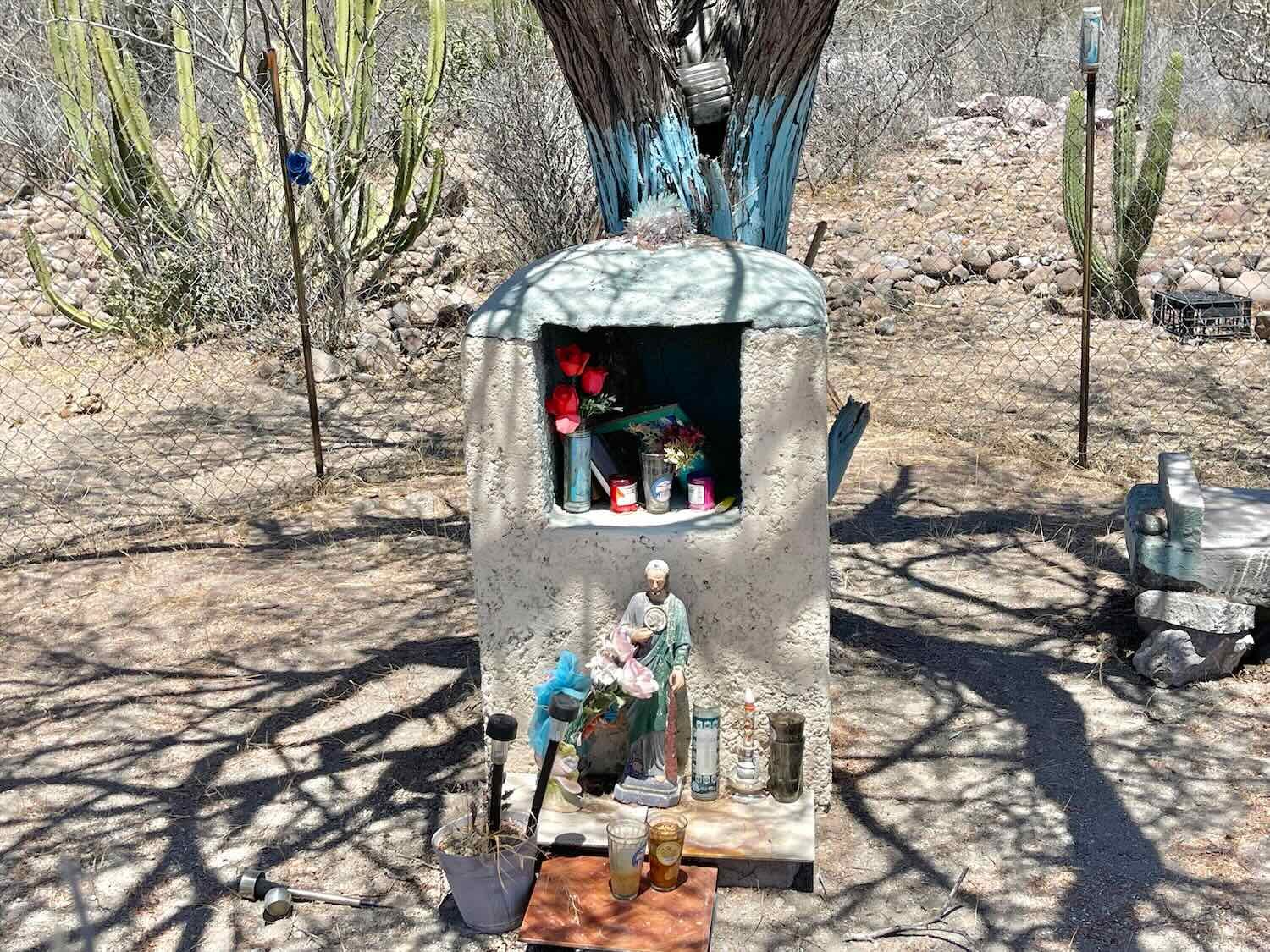
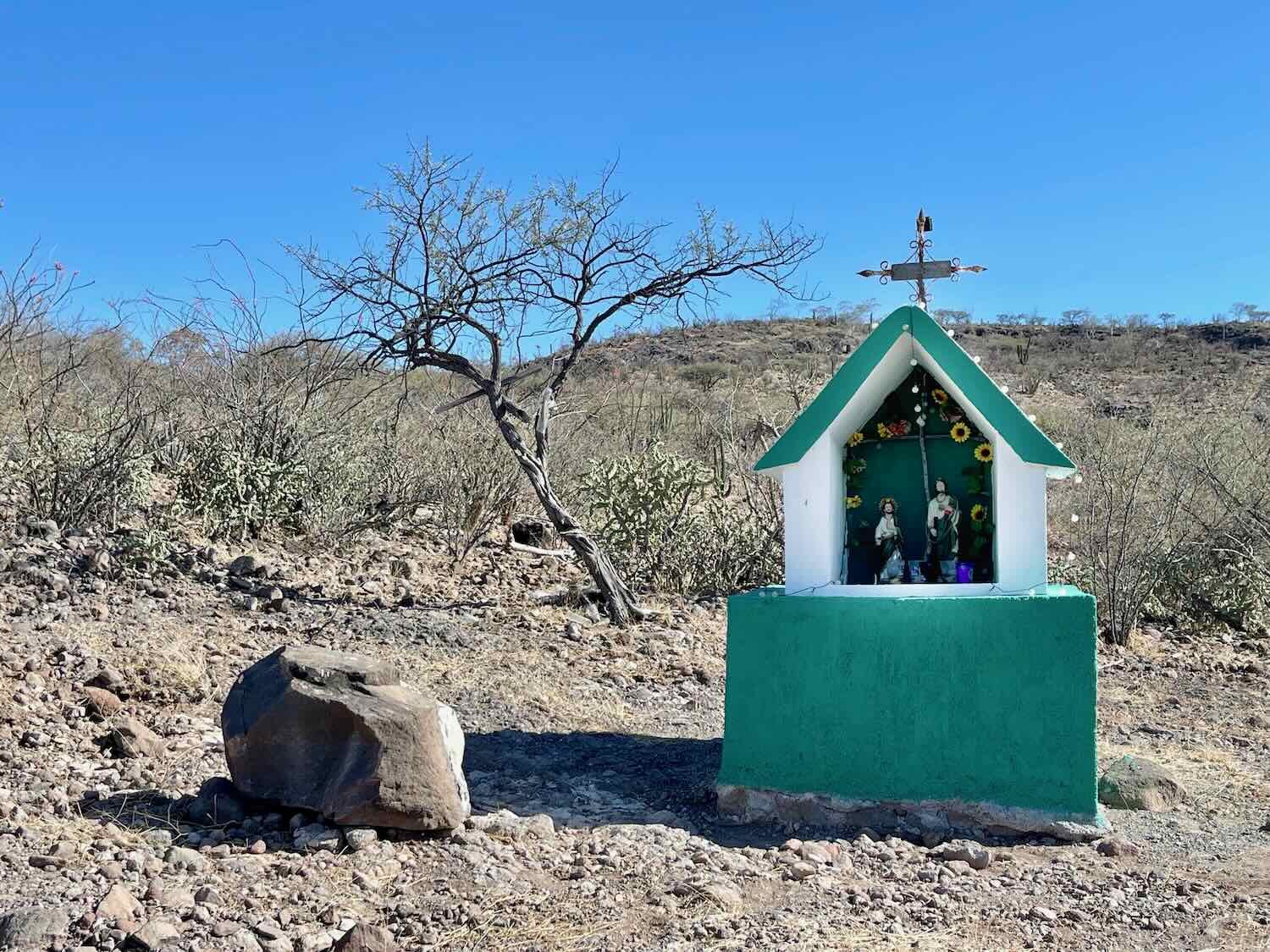
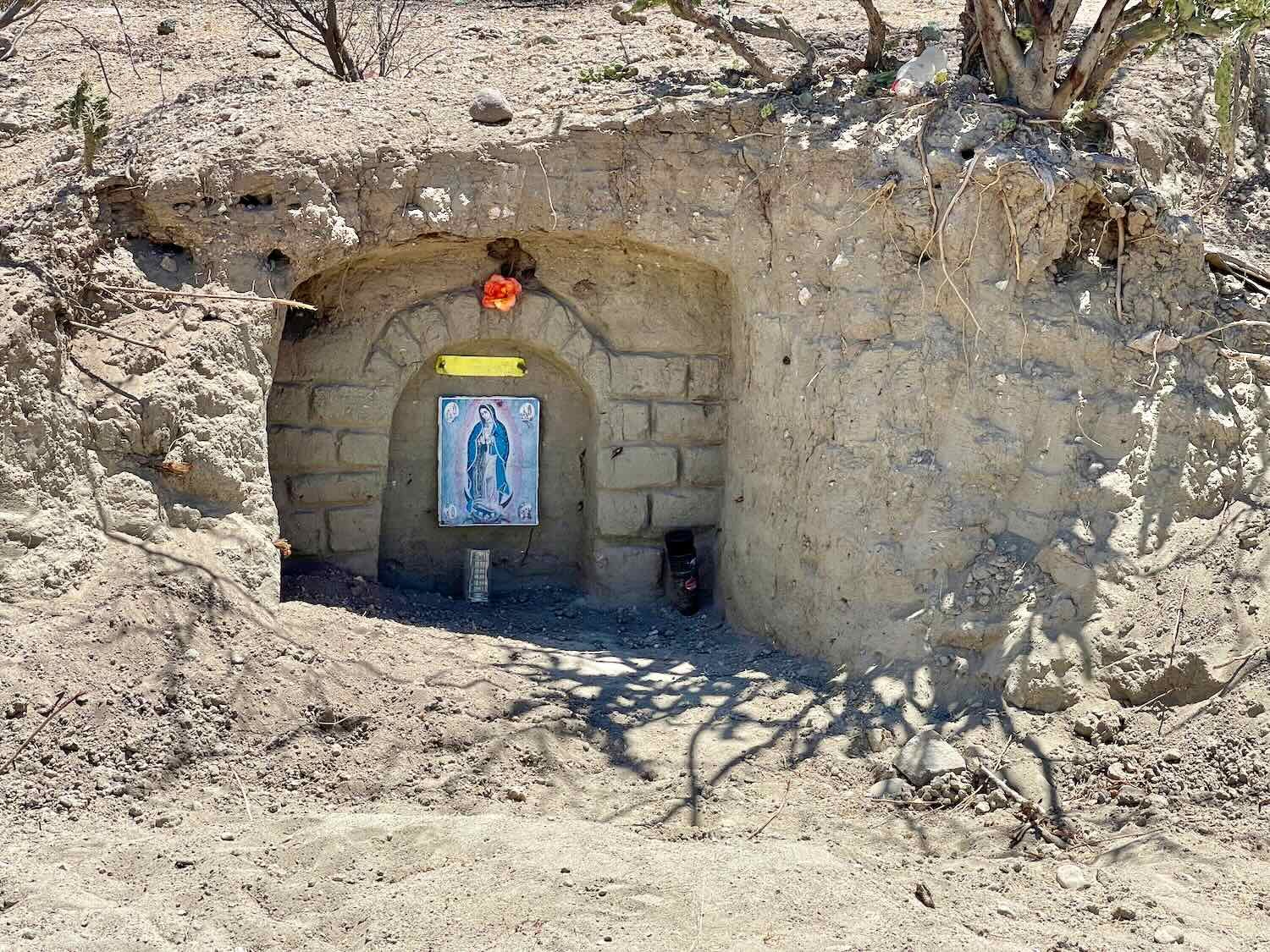
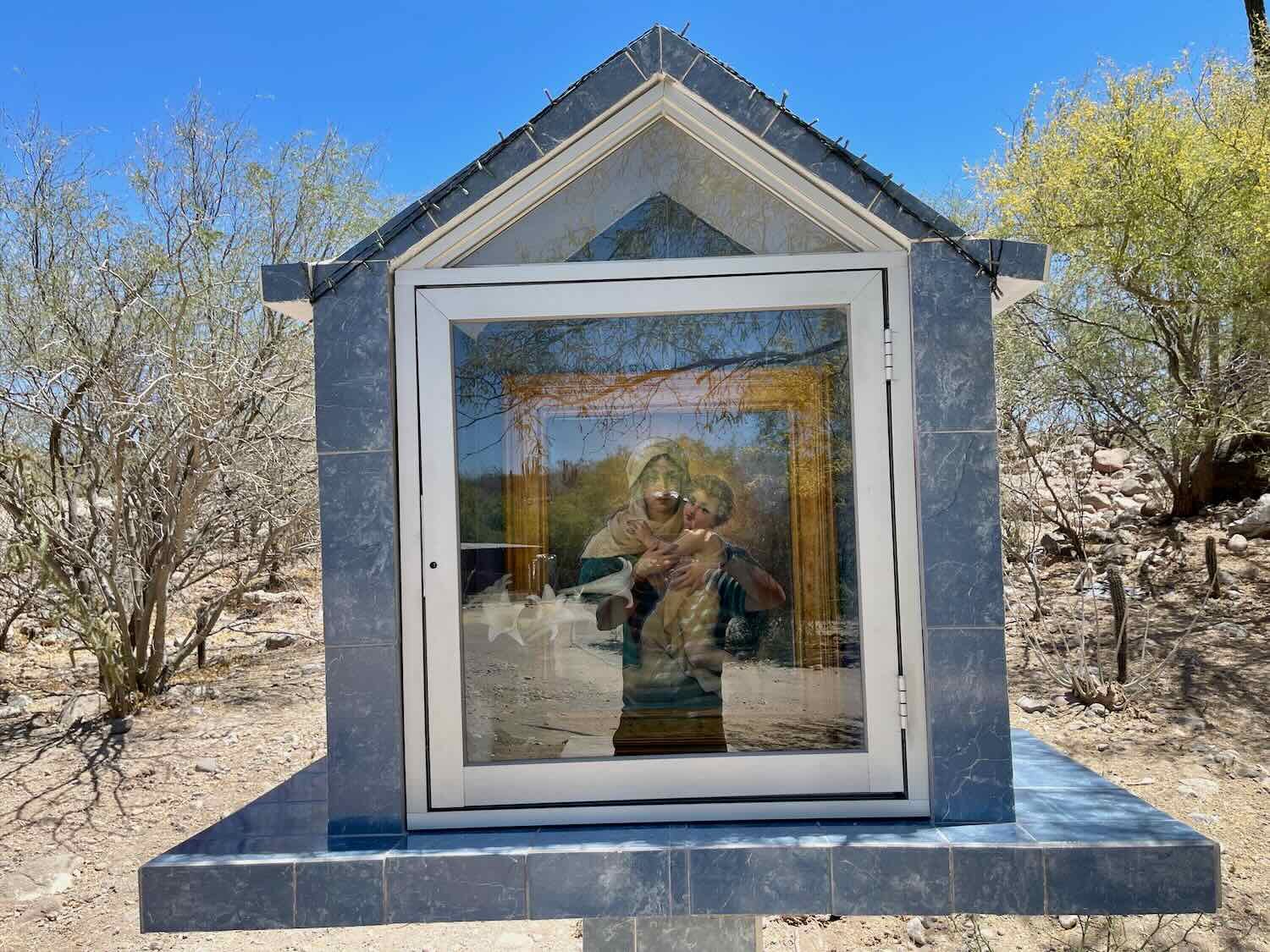
As the day grew hotter, we slowed down. We took a welcome break in the shade, where a cliff came right up to the road. As we rested, a pyrrhuloxia sang from a nearby tree.
A male pyrrhuloxia sang for us as we rested in the shade. Arroyo La Presa, Baja California Sur, Mexico. Copyright © 2019-2023 Pedals and Puffins.
But after that, shade was extremely scarce. Although we could have stopped to camp, the thought of just sitting around in the hot sunshine was a non-starter. We pushed on through the heat and made it all the way to the little village of Las Ánimas (pop. 68).
Although the Baja Divide crossed multiple arroyos after passing through San Luis Gonzaga, many of them were paved with concrete spillways that made getting across the riverbed quick and easy. That made the river crossings much more enjoyable than the many rivers we had crossed earlier on the route. Arroyo La Presa, Baja California Sur, Mexico. Copyright © 2019-2023 Pedals and Puffins.
The arid landscape as we approached Las Ánimas, Baja California Sur, Mexico. Copyright © 2019-2023 Pedals and Puffins.
On the way into the village, we passed a small, brightly painted chapel. Las Ánimas, Baja California Sur, Mexico. Copyright © 2019-2023 Pedals and Puffins.
We arrived at the village around 4:30 in the afternoon. At a ranch perched right along the edge of the Arroyo San Pedro, a sign out front welcomed cyclists on the Baja Divide and offered food, lemonade, coffee and camping. We were ready to call it a day, so we parked our bikes and approached the house.
At first it seemed like no one was around. But a car was parked out front, so we hoped that was a sign that someone was home. We called out several times until an older woman named María Guadalupe came out. She offered us a seat in the shade under the palapa, and asked us to wait until the others returned. We rested in the cool breeze, glad to be off our bikes.
Pretty soon her husband, Narciso, arrived with a younger man who might have been his son. They were all very welcoming and kind. María made us a big pitcher of limeade using limes from their orchard, while we sat and chatted with Narciso under the palapa. We learned that the family had lived at this ranch for 18 years, and that they had moved here from another ranch nearby. In addition to the orchard and a thriving flower garden, they kept a veritable menagerie of animals including chickens, turkeys, rabbits, goats, a couple of dogs and cats, plus some cows that were out in the desert at the moment. As we talked, hummingbirds fought with each other over rights to the flowers nearby.
Narciso and his wife invited us to camp near their house. We hoped to have dinner with them, and it was getting too late to try and squeeze in any more cycling. So setting up our tent in their yard seemed like a good idea. They said we could put our tent anywhere in their yard, but it was a little difficult finding a spot large enough for our tent. We had to displace a few chickens and turkeys from one of their favorite corners of the yard, but no one (including the chickens) seemed to mind too much. We ended up pitching our tent among a small grove of trees. Little did we realize that the chickens would get their revenge at about 3am in the morning.
Our campsite at the ranch. We found a nice, level spot among a small grove of trees. Las Ánimas, Baja California Sur, Mexico. Copyright © 2019-2023 Pedals and Puffins.
After everything was set up, we went for a relaxing walk down to the water’s edge in the arroyo. We were fascinated to see a dozen gas-powered pumps stationed next to the various pools of water in the arroyo, attached to hoses that led to nearby houses. We hadn’t seen water used that intensively in any of the other villages we had passed. Just upstream from the ranch, a tall cliff as beautiful as El Capitán at Yosemite rose high above the town.
Some time between 6:00-6:30pm, two other cyclists rode by. We didn’t see them, but the ranchers told us they had passed. Narciso said they must have been in a hurry, because they didn’t stop.
As dusk fell, we enjoyed a delicious meal of fried eggs, lots of frijoles, home made tortillas, and a wonderfully ripe tomato from their garden. We’re always a little bit nervous about eating produce like tomatoes outside of well known restaurants. But we ate it anyway, because it looked and tasted so good. After dinner we went straight to bed, totally exhausted.
Up Into the Sierra Giganta, Again
Unfortunately, it was a very noisy night. That wasn’t totally unexpected. There were chickens and dogs, after all. But this proved to be a particularly active bunch of animals. The four dogs barked and growled at intruders - whether real or imagined - most of the night. The rooster, perched no more than 10 feet from our tent, decided that everyone should wake up at about 3:00am. When our rooster started calling, many of the other neighborhood roosters would respond. It really is hard to describe how loud a rooster can be when it is calling just a few feet away. Suffice it to say that we can not think of single animal in the world that is louder.
Neither one of us got a good night’s sleep. We arose around 5:30am. There wasn’t much point in trying to stay in bed any longer. All the many animals on the farm were up and making noise.
Unfortunately, PedalingGal had an unpleasant start to the day. We both had parked our bikes under the trees. But apparently PedalingGal’s bike was right beneath a spot where local birds liked to roost for the night. In the morning, her bike was covered with a whole lot of bird poop. PedalingGuy got away unscathed. But PedalingGal had to spend 15-20 minutes cleaning all of the droppings off of every surface, and out of every crevice, on her bicycle. Lesson learned.
As we were getting ready to leave, Narciso came into the palapa carrying two adorable baby goats. He said they were only five days old. Las Ánimas, Baja California Sur, Mexico. Copyright © 2019-2023 Pedals and Puffins.
The climb out of the river valley was steep, but it didn’t last very long. Then, for about a half mile, the road was actually pretty level and the cycling was easy. At first we could see the tracks left by the other two cyclists that had passed late the day before. But pretty soon they disappeared. They were probably still in their camp, and we had passed them by.
Pushing up out of the Arroyo San Pedro valley in the early morning light. Just past Las Ánimas, Baja California Sur, Mexico. Copyright © 2019-2023 Pedals and Puffins.
But then we hit a really big, really, really steep hill. Much of it was paved with concrete, which was pretty much the only thing that made it possible for anything with wheels to make it to the top. For about 1.5 miles (2.4 km) we slowly trudged up the hill, pushing our bikes, and stopping frequently to catch our breath. It didn’t help that we had just loaded up with 16 liters of water - adding more than 35 pounds of weight between us.
Just short of the top of the hill we stopped to take a break in the shade of a small cliff next to the road. It was a good thing we had tackled that hill first thing in the morning. We had already overheated, even in the cool, morning air. As we rested in the shade, we ate a hearty breakfast of bread and cheese.
Our bikes, huddled against the side of the cliff as we rested in the shade. Leaving Las Ánimas, Baja California Sur, Mexico. Copyright © 2019-2023 Pedals and Puffins.
As we were packing up after breakfast the other two cyclists came up the road, slowly pushing their own bikes. And so we met Kenny (from Alaska) and Eric (from North Carolina). They were both tired as well, and stopped to chat with us while catching their breath. We ended up talking with them for quite a while, mostly about bicycle gear and conditions we had encountered on the trail. They guessed who we were (Pedals and Puffins), because they had seen our entries just ahead of their own in various guest books. We were a little bit jealous because they were traveling very light - especially Kenny. He had taken up cycling after spending time as an ultralight, long-distance backpacker. So he had perfected a setup that was light and small. Another reason they could travel so light was that they were only cycling the Baja Divide, and would return home after completing the ride. Our set-up would be much different and lighter if we were cycling just the Baja Divide. Cycling a much longer distance, over a longer period of time and over much more varied terrain, requires carrying a few more things to be comfortable.
It was a good thing they were traveling light, because they had a lot of miles to cover. They told us they were on a tight schedule, and had to be in Cabo to catch a flight home in 10 days. So after we said our goodbyes, they bounded away, up and over the top of the hill, before we were fully packed from our breakfast break.
Moments later, a guy from Las Ánimas came running up the hill. He was very friendly and tried to chat with us, but he had an accent that made him a little bit hard for us to understand. Among the tidbits that we did comprehend was that he had a nephew who spoke English, and that he was going up the hill to look for his cows so that he could drive them down to the river for water. He also told us that the road would level out very soon, which was great news. Then he turned away and bounded up a steep cow path, like only someone who goes up and down these mountains every day could.
Before long, he was driving his cows back down the road toward us. The cows didn’t like the sight of us, and some went off the road onto a precipitous cliff for fear of passing us. But the rancher took it all in stride. We have found that ranchers, cow herders and goat herders all seem to be very calm about everything. Nothing appears to bother them. We hoped that our presence didn’t mess up the guy’s plans too much and that the cows made it down safely.
Happily, he was right about the road. Very shortly after we passed him for the second time, the route became much more level. It was a thrill to finally reach the top of the ridge. The steep ride down the far side of the pass wasn’t so bad. A lot of the steepest sections were paved, and the views down the canyon were awesome. More than once we had the feeling of standing on the rim of the Grand Canyon in Arizona.
The view from the top of the first pass (of two) through the Sierra La Giganta. Baja California Sur, Mexico. Copyright © 2019-2023 Pedals and Puffins.
Nearly four hours into the ride we reached the bottom of the canyon where several arroyos come together. That’s where we first saw the famous pink and green rocks that are typical of this area. As we began the climb away from the creek at the bottom of the pass, there were spectacular pink and green outcrops all along the canyon walls.
A couple of goats practice their rock climbing skills on the colorful cliffs down in the valley. Arroyo Purificación, Baja California Sur, Mexico. Copyright © 2019-2023 Pedals and Puffins.
A view up the valley, with colorful cliffs lining the canyon. Arroyo Purificación, Baja California Sur, Mexico. Copyright © 2019-2023 Pedals and Puffins.
We made it to the tiny settlement of La Soledad (pop. 15) right around noon. But by then, lack of sleep was catching up with us. We rested in the shade of an acacia tree near a roadside shrine. Some cookies and salt tablets helped to boost our energy, at least a little bit.
However, once we left La Soledad and the afternoon heat started to really bake the land, our progress slowed to a crawl. It was clear we would not make it as far as San Evaristo (on the coast) that day. In fact, we only managed to cover 3.5 more miles (5.6 km) in the next 2.5 hours.
Just as we were coming to the conclusion that we should stop for the day, a group of nine Ford Raptors drove past. We were reminded of the flock of Raptors that had passed us out on the road between Bahía de los Ángeles and San Rafael, several weeks ago. This was probably a different club than the first one, but it struck us as interesting that there would be multiple Ford Raptor clubs out cruising the backroads of Baja.
After they passed, we noticed that there was some flat land nearby. We also were in a stunningly beautiful canyon bordered by majestic cliffs. What better place to spend some time, soaking up the essence of the Baja desert? It was time to find a place to camp.
We looked around, and found a flat, open space near a huge organ pipe cactus. But since it was still relatively early in the afternoon, we didn’t pitch the tent right away. Once again, we set up our camp chairs in the shade, and rested our tired bodies. In the end we only managed to cycle about 14.5 miles (23 km), making this one of our shortest days ever. The combination of lack of sleep, intense heat, rough road surfaces and steep terrain all took their toll.
Eventually the sun moved toward the horizon, and it was time to set up camp. We went over to the space beside the organ pipe cactus and started clearing a site for the tent. But within minutes, we spotted clusters of sharp spines in the sand, that had been dropped by the cactus. And pretty soon we were alarmed to find dozens, then scores, then literally hundreds of the little spike-balls all over the area where we had hoped to pitch our tent. They were so sharp that they would stick in your finger if you barely touched them. They were definitely sharp enough and long enough to easily puncture our inflatable sleeping pads (and to poke through the bottom of the tent, causing painful pin-pricks in our skin).
Conventional wisdom for camping in Baja says that it is best to use closed foam sleeping pads that do not need to be inflated (and thus are not subject to being punctured). That is great advice. But closed foam pads, which we have used in the past, are rather uncomfortable. Since our trip is much longer than just Baja, we decided to take a chance by using the more comfortable, inflatable sleeping pads. It’s a risky proposition. A hole that can’t be patched in an inflatable sleeping pad renders it no better than seeping directly on the ground. Furthermore, replacing good, lightweight camping gear in Mexico has so far proved impossible. We had made it through most of Baja without a sleeping pad cactus puncture, but we were now wondering if our luck had run out.
Dismayed, we actually spent some time scoping out the surrounding area in hopes of finding a different place to pitch the tent. But we were in a veritable organ pipe cactus forest. And try as we might, we could not find another place big enough for our tent that wasn’t right next to another cactus. At that point, we even considered getting back on our bikes and heading up the road to take our chances at finding a different area to camp. Unfortunately, it was already late in the day, and we ran the risk of having darkness fall without finding a usable campsite. We decided that we had to make this site work.
We spent a very long time hunched over and scanning the earth to locate and remove the spines. Even when we got to the point of not being able to see any more of the spines, if we put a hand down and patted the ground, we would soon feel the prick of one of the spines that was mostly buried, but poking up through the sand. After at least an hour of searching, we felt like we had done the best we could to clear the site. But even then we could not be sure we had gotten them all.
As an extra precaution, we decided to put down a ground cloth under the tent, which we normally don’t bother to do. Then we set up camp and crossed our fingers. We certainly had learned our lesson the hard way - don’t pitch your tent in an area with a lot of organ pipe cactus!
Our gorgeous campsite in the Sierra La Giganta, next to the giant, beautiful, organ pipe cactus that had booby-trapped our campsite with an enormous number of sharp spines, waiting to puncture our sleeping pads. East of La Soledad, Baja California Sur, Mexico. Copyright © 2019-2023 Pedals and Puffins.
Just a few of the cactus spikes that we removed from the area where we pitched our tent. They were small and thin enough to easily blend in with the other vegetation in the sand - making them difficult to see. Sierra La Giganta, Baja California Sur, Mexico. Copyright © 2019-2023 Pedals and Puffins.
It was a blissfully quiet night. We both fell into a deep, satisfying sleep.
In the morning we were delighted to discover that miracles do happen. Both of our inflatable sleeping pads survived the night. And as if to remind us of the bullet we had just dodged - when we picked up the ground cloth from under the tent it had three of the little spine balls stuck in it. Good thing we used the ground cloth. It probably protected our sleeping pads just enough, even though it certainly could be easily punctured by the spines. We could not have been happier. Anyone thinking of cycling Baja may want to consider taking a Tyvek ground cloth. Rumor has it that most spines are not able to penetrate Tyvek, although we have not tested this.
Returning to the Sea of Cortez
The climb to the top of the second pass through the Sierra La Giganta was still very tiring, but it was infinitely easier and more pleasant in the morning. It was slow going, taking us about two hours to cycle just over four miles to the top.
Climbing up to the final pass through the mountains in the early morning, with the sun still hidden behind the ridge. Sierra La Giganta, Baja California Sur, Mexico. Copyright © 2019-2023 Pedals and Puffins.
A cardón cactus in bloom. Sierra La Giganta, Baja California Sur, Mexico. Copyright © 2019-2023 Pedals and Puffins.
Striking rock formations near the top of the pass, with palo verde trees in bloom. Sierra La Giganta, Baja California Sur, Mexico. Copyright © 2019-2023 Pedals and Puffins.
As soon as we crossed over the summit of the pass, the rich blue water of the Sea of Cortez came into view, with San Juan Island stretching across the horizon. We stopped briefly at the top, reminded of how amazing it feels to cycle over a high mountain pass and be greeted by such an awesome sight.
The descent towards the coast was quite steep. We lost 1,400 ft of elevation (425 m) in three miles, on roads strewn with loose rocks and gravel. We worked our way down the canyon while trying not to totally lose control. We both fell off our bikes a couple of times - which is unheard of for PedalingGuy. But except for a few scrapes, we came through relatively unscathed.
Plummeting down the steep descent from the heights of the Sierra La Giganta to the Sea of Cortez. The distant mountains are on San Juan Island. Reserva Natural Portezuelo, Baja California Sur, Mexico. Copyright © 2019-2023 Pedals and Puffins.
There was one, last, very steep hill to cross at the turnoff to San Evaristo (pop. 70) - part of a ridge that encircles the town. From the top of the hill we saw the inviting blue waters of the bay, bordered by an arc of white, sandy beach. It looked like paradise.
The beautiful bay at San Evaristo. A restaurant and cabin awaited us down in the town by the bay. San Evaristo, Baja California Sur, Mexico. Copyright © 2019-2023 Pedals and Puffins.
We eagerly bounded down the far side of the ridge, and rolled up to Lupe Sierra and Maggie Mae’s restaurant around 11am. The sun was already beating down. So we were thrilled to arrive early at this travelers’ oasis before the day got even hotter.
Paradise by the Bay
Lupe Sierra and Maggie Mae’s is an interesting place. They serve a steady stream of travelers that arrive by boat, off-road vehicle, motorcycle, and of course bicycles riding the Baja Divide. There is a very small restaurant, with mostly outdoor seating - either on a patio near the restaurant or under palapas on the beach. Nestled beside the restaurant are six, little cabins and one big one. We took the big one so that we could have room for our bikes inside.
The cabins came with a washing area that included a big jug of water (with a spigot), a bucket to catch the water, and hand soap. There were a couple of windows that allowed for a nice cross-breeze. And the comfortable beds came with those brightly-colored, plush blankets we’ve gotten used to seeing in Baja.
Inside our palm roofed cabin at Lupe Sierra and Maggie Mae’s. San Evaristo, Baja California Sur, Mexico. Copyright © 2019-2023 Pedals and Puffins.
After settling into the cabin, we headed for the showers to wash off four days worth of dust, sand and salt. It took a while, because the “showers” were the same kind we encountered at the San Ignacio Lagoon - fill a bucket with water, and use a large cup to pour the water over yourself. But when we were done it felt fabulous to be clean.
For lunch, we headed down to one of the palapas on the beach. It was then that we realized what a gem we had discovered. Sitting in the shade, with the ocean breeze, the view of sailboats in the bay, the sound of seagulls in the air, and a pile of fish and shrimp tacos on the table - we felt all our cares melt away. It was the ultimate Baja experience. Pretty soon we had decided that we would spend an extra day here, just living in the moment.
Our favorite lunch spot, under a palapa on the beach. San Evaristo, Baja California Sur, Mexico. Copyright © 2019-2023 Pedals and Puffins.
The tables on the beach came with their own guard dog. This adorable little guy joined us for every meal. He didn’t beg, or even try to hard to get our attention. He just seemed content to rest in the sand near our feet, and enjoy the occasional ear scratch. San Evaristo, Baja California Sur, Mexico. Copyright © 2019-2023 Pedals and Puffins.
We sat and relaxed by the beach for a long time, watching the gulls fight over fish scraps and the sailboats coming and going from the bay. Several folks from the boats came over to the restaurant for a meal, and that’s how we met Mac and Jenny, who have been cruising the west coast of North America in their 37 ft sloop, Maya, with a special affinity for Baja. They were great to talk to, and had some tips for us regarding the ferry from La Paz to Mazatlán (which we plan to take soon). We learned that they were from Anacortes, Washington, an area we had cycled through back in October 2022. Small world.
Later in the afternoon we walked over to the town’s only store. Along the way we ran into Mac and Jenny again, who were on the beach playing frisbee-fetch with their enthusiastic dog, Disco. He was a really great fetcher, retrieving the frisbee in the blink of an eye, whether it landed on the sand or in the water, and rushing it back to Jenny for another throw. At the far end of the beach we passed the recently upgraded desalination plant. The plant fills a big tank to supply the town with drinking water, which is delivered to every residence, by truck, weekly.
The spiffy, new desalination plant. San Evaristo, Baja California Sur, Mexico. Copyright © 2019-2023 Pedals and Puffins.
The store turned out to be a really tiny tienda. It focused on items that wouldn’t spoil, like dried beans, a few canned foods, plus the usual cookies and chips. There wasn’t that much for us to buy. But we did grab a couple of cold drinks, some cookies and chips. An ice cream bar, to top it off, was a nice treat.
As we were getting ready to walk back to the cabin, the owner of the store rolled up with a wheelbarrow. Inside was a big, beautiful yellowtail (a.k.a., amberjack). We’ve heard several times that the most commonly served fish in Baja is the yellowtail, and that it’s also a popular sport fish. But this was our first opportunity to see one that wasn’t already reduced into taco-sized fillets.
This yellowtail arrived at the town’s small store in a wheelbarrow. The owner had probably just purchased it from a fisherman down at the beach. San Evaristo, Baja California Sur, Mexico. Copyright © 2019-2023 Pedals and Puffins.
In the evening, Lupe’s restaurant was packed. There were now nine boats anchored out in the bay, and many of the crews had come ashore for dinner. Once again we ate down by the water, with our friendly dog to keep us company. A couple of other small dogs wandered through. And each time, the resident dog growled menacingly as if to ward off the intruder, with zero success. After the initial display of aggression, the dogs would approach each other with tails wagging and make amends. All of the dogs had a similar build, and we suspected that they were related to each other. The sun set over the distant mountains as we relaxed under the palapa in Baja paradise.
Sunset over the San Evaristo Bay. Baja California Sur, Mexico. Copyright © 2019-2023 Pedals and Puffins.
During our first night in San Evaristo the wind kicked up to nearly 40 mph for several hours. It was crazy. Our cabin weathered the gale just fine, but we certainly were happy that we had not been out in our tent. The next morning, Lupe and his daughter were out repairing the big canvas awning that provides shade for some of the restaurant’s tables, which had blown down over night. Later we also heard from some of the boaters that they had spent a sleepless night battening down the hatches and monitoring their anchors to be sure that the boats didn’t drift into each other, or onto the rocky reef at the mouth of the bay.
We spent another restful day in San Evaristo, relaxing by the beach, wandering around town, and eating the great food from the restaurant. Throughout the day a parade of boats came and went, sailing in and out of the bay. The restaurant owner and staff were incredibly generous, offering us free bananas and papaya between meals. We learned that Lupe, one of the owners and managers, is an avid cyclist, and has participated in some long-distance mountain biking races over the years. We also had the chance to meet a number of other folks from the boats, including a very nice couple from Texas traveling on a motor boat, a couple from Tahoe, California who showed us photos of their snow-covered home (the husband had also sponsored and participated in the Tour of the California Alps bike ride, a.k.a., the “death ride”), and a group of three guys from California that included a avid cyclist who chatted with us about the challenges of cycling through the mountains of Baja.
As we sat under the palapa visiting with other guests, a team of magnificent frigatebirds ganged up on the local seagulls who were gorging on fish parts discarded by the returning fishermen. Frigatebirds are habitual thieves, and they used all of their aerial acrobatic skills to try and steal the fish from the gulls. It was thrilling to watch.
Unfortunately, that night we had some new neighbors in the cabins and they stayed up a bit late, chatting and coordinating with each other. Then, after they finally went to bed, one of them ended up snoring loudly throughout the night. We eventually got some sleep, but not until early in the morning.
Green Rocks, a Big Blue Shrimp, and a Pink Ocean
Just as we were getting ready to leave in the morning, the little black and brown dog from the beach spotted us from a distance and came bounding over for one last scratch behind the ears. It was really adorable.
From the top of the hill surrounding San Evaristo, we took one last look back at the beautiful bay.
San Evaristo Bay in the morning light. Baja California Sur, Mexico. Copyright © 2019-2023 Pedals and Puffins.
For the first couple of hours the terrain was pretty flat. So in spite of some deep sand and washboards, we made good time. Along the way, the sheer cliffs of the Sierra La Giganta marched along on our righthand side.
The colorfully striped cliffs of the Sierra Giganta, seen from the coastal road. South of San Evaristo, Baja California Sur, Mexico. Copyright © 2019-2023 Pedals and Puffins.
But then we hit the big hill at Punta Mechudo. Even with our fresh legs, the climb was a beast, with some of the slopes reaching gradients of 20%. We ended up pushing our bikes up most of the way. And we even had to put two-to-a-bike to get up the final stretch, even though it was paved with concrete. We noticed that there were payer boxes at both the top and the bottom of this steep, treacherous section of road, perhaps for anyone needing a little extra help before driving up or down in a vehicle.
It took us an hour and a half to get to the top of the pass. At least the scenery was amazing, so we could enjoy the views each time we had to stop and catch our breath.
Fascinating sandstone ribbons on a roadside cliff. Punta Mechudo, Baja California Sur, Mexico. Copyright © 2019-2023 Pedals and Puffins.
Pushing our bikes up the final stretch, one bike at a time. Punta Mechudo, Baja California Sur, Mexico. Copyright © 2019-2023 Pedals and Puffins.
On the way down the other side of the ridge, the road cut right through the layers of green rock. We’d never seen so much stone that deep of a shade of green before.
A stunning, green outcrop bordered the road. Punta Mechudo, Baja California Sur, Mexico. Copyright © 2019-2023 Pedals and Puffins.
View to the south, descending off of Punta Mechudo. Baja California Sur, Mexico. Copyright © 2019-2023 Pedals and Puffins.
The “Mechudo Crag” a prominent landmark along the road from San Evaristo. Peñón El Mechudo, Baja California Sur, Mexico. Copyright © 2019-2023 Pedals and Puffins.
When we finally made it out of the hills, the route flattened out again. However, the road surface continued to present challenges with sand and washboards. Eventually we decided to air down our tires to 16 psi. That helped a lot. But there still were some sections where the sand was too deep to ride. As the afternoon heat set in, we stopped often under roadside trees to cool off in the shade.
Occasionally we passed clusters of fishing boats on otherwise deserted beaches. Fishing is still a mainstay of people’s livelihoods in many parts of Baja. Playa El Portugues, Baja California Sur, Mexico. Copyright © 2019-2023 Pedals and Puffins.
A little after 1pm we rolled into the tiny, down-on-its-heels town of Punta Coyote (pop. 11). Based on reports from other cyclists, we didn’t have high expectations for the town’s store. But we figured we might as well stop and see what they had on hand. However, this was another town where it was not apparent which building was the tienda. We stopped and asked a guy at a house nearby if there was a store in town, and he told us that it was closed because the lady who ran it was in La Paz. With that news, we got ready to head down the road.
The town sign for Punta Coyote, barely legible, is indicative of the overall state of the village. Punta Coyote, Baja California Sur, Mexico. Copyright © 2019-2023 Pedals and Puffins.
But a moment later, another guy came running over to us. He’d been speaking with someone on his cell phone who said there was another store we could go to. It was back the way we had come, but he assured us three or four times that all we had to do was make a left turn “just 200 or 300 meters” away. So we decided to give it a try.
We cycled back toward San Evaristo for half a mile before turning on the first road we came to that headed to the left. That road led back to a ranch. But when we arrived there, the rancher told us that the tienda was another mile or so back to the north, across a couple of arroyos. There was no way we were going that far out of our way, especially without any assurance that the tienda would really exist. We thanked the rancher, gave up on the hope of any cold drinks, and head back in the direction of La Paz.
Shortly after the aborted shopping attempt in Punta Coyote, we stopped in the shade of a tree for a break. Suddenly, PedalingGuy spotted a big pod of dolphins speeding through the water. They were racing along, and jumping out of the water as they went. The line of dolphins at the head of the pod even seemed to coordinate their movements, often leaping out of the water at the same time. It was thrilling, and beautiful to watch.
A pod of dolphins races through the water. South of Punta Coyote, Baja California Sur, Mexico. Copyright © 2019-2023 Pedals and Puffins.
The cliffs of the Sierra La Giganta continued to provide a gorgeous backdrop to the west. South of Punta Coyote, Baja California Sur, Mexico. Copyright © 2019-2023 Pedals and Puffins.
This herd of cattle barely fit under the only tree around. Like us, they preferred to cool off in the shade and escape the afternoon sun. South of Punta Coyote, Baja California Sur, Mexico. Copyright © 2019-2023 Pedals and Puffins.
About 10 miles (16 km) south of Punta Coyote we reached the Granjas Sureño shrimp farm. It’s a big operation, with 124 ponds fed by saltwater from the Sea of Cortez. From the road we couldn’t see much of the shrimp ponds. But we did spot one, very large, blue shrimp.
Large shrimp statue near the guardhouse of the Granjas Sureño shrimp farm. South of Punta Coyote, Baja California Sur, Mexico. Copyright © 2019-2023 Pedals and Puffins.
Just a couple of miles past the shrimp farm we called it a day. We headed down a long dirt road toward the beach. After cycling toward the ocean for about half a mile, we reached a spot where the road descended onto a sandy beach that encircled a picturesque, green stone cliff. We found a great location for our tent on a high spot in the sand, between the ocean and the cliff. The combination of the ocean, a rugged island in the distance, and the green cliff behind us was stupendous. It may have been our most incredible campsite yet.
Walking out onto the beach to look for a campsite. Large, flat outcrops of smooth green stone (polished by the sea) intermingled with the sand. Punta El Guano, Baja California Sur, Mexico. Copyright © 2019-2023 Pedals and Puffins.
We pitched the tent, and enjoyed a simple dinner while sitting in our camp chairs, looking out over the ocean.
One of our best wild campsites, ever. The green cliff was practically the same color as our tent. Punta El Guano, Baja California Sur, Mexico. Copyright © 2019-2023 Pedals and Puffins.
Just as the sun was setting the sky turned bright pink. The water in the ocean reflected the color of the sky, and turned a fabulous shade of mauve. We had never seen anything like it. There was the pink sea, bordered by a pale blue sky, with pink clouds above it. The effect was psychedelic, and very beautiful at the same time. A fishing panga set off from a beach a couple of miles away, and we watched as it sped out across the pink surface of the water.
As the sun set, the Sea of Cortez turned an astonishing shade of pink. Playa El Guano, Baja California Sur, Mexico. Copyright © 2019-2023 Pedals and Puffins.
We were both very tired from lack of sleep the night before, and PedalingGuy was asleep as soon as his head hit the pillow. The only sound all night was the waves lapping against the shore a short distance from our tent. No chickens. No snoring tourists. Not even any noisy seagulls to wake us up in the morning. It was perfect, one of those ideal Baja beach experiences.
The End of the Road in Baja
In the morning we noted that the high tide had come within about 30 feet of our tent. But luckily we had pitched it on a high point, so everything stayed dry. And at dawn, the tide was out far enough to expose even more of the green bedrock at the edge of the sand.
Morning sun on our campsite, turning the green cliffs into gold. Punta El Guano, Baja California Sur, Mexico. Copyright © 2019-2023 Pedals and Puffins.
The morning was beautiful, and we felt reluctant to vacate our campsite too soon. We decided to go for a walk on the beach before departing. That’s when we noticed a fresh set of coyote tracks in the wet sand. They led directly away from our bikes. The coyote must have come within a few feet of our tent, sniffed our bikes, and passed between the cliff and our tent before heading away down the beach. We hadn’t heard anything during the night. The footfalls of a coyote in soft sand would have been pretty hard to hear compared to the crashing waves.
Along the beach we admired some brightly colored seashells, as squadrons of brown pelicans patrolled the coast. A few magnificent frigatebirds wheeled in the sky overhead.
The route from our campsite to the town of San Jose de la Costa was pretty similar to the day before, with sand and washboards in the road, and a few more steep hills. The mountains to our west continued to march along with us, in a colorful layer cake of cream, pink and green hues.
A layer cake of colors in the Sierra La Giganta. North of San Juan de la Costa, Baja California Sur, Mexico. Copyright © 2019-2023 Pedals and Puffins.
Then, as we approached San Juan de la Costa, the mountain foothills came right down to the edge of the sea. With nowhere else to go, the road settled down onto a flat bench that the road engineers carved directly into the cliffs. We picked up our pace in anticipation of reaching the next town in time for lunch.
But several sights along this part of the road caused us to stop in our tracks. First, we spotted another pod of dolphins racing through the surf. It had about the same number of animals as the one we had seen the day before, and their behavior was strikingly similar as they bounded through the water and leaped into the air. We wondered if it was the same group. We estimated that there were at least 20-40 individual dolphins, a larger group than we are used to seeing in other places.
This pod of dolphins reminded us of the one we had seen the day before, as they raced and splashed through the water in the Sea of Cortez. Playa El Saladito, Baja California Sur, Mexico. Copyright © 2019-2023 Pedals and Puffins.
Right after that we came upon a forlorn shipwrecked boat that looked like it had been sitting on that sand bar for quite a while. And just past the shipwreck, we passed the main entrance to a big phosphorous mine. A couple of great blue herons had set up a mini rookery atop some electrical poles connected to the mine.
This shipwreck was stuck on a sandbar not far from San Juan de la Costa. We couldn’t find any information about the boat, or how it came to be trapped here. Punto Dos, Baja California Sur, Mexico. Copyright © 2019-2023 Pedals and Puffins.
Two nests is a bit small for a great blue heron rookery, but that’s all that the telephone poles had room for. Entrance to the Rofomex Mine, North of San Juan de la Costa, Baja California Sur, Mexico. Copyright © 2019-2023 Pedals and Puffins.
From there it was a short, quick run into the town of San Juan de la Costa (pop. 146), which serves as a gateway to the big mine. Unfortunately, the last third of a mile shot up a nasty 10% grade to reach a store at the top of the hill. PedalingGuy actually asked whether it was worth it to climb to the top. But we needed to fill up on water, and it would be nice to take a break with drinks and food. So we pushed our way up the hill, finally arriving at the store.
In the end we were glad we made the effort. It was a great, little shop and the owner was very friendly. We each polished off a couple of bottles of cold drinks, while snacking on bananas and muffins. By the time we were done, we couldn’t eat any more.
At that point it was still well before noon. So we began to consider the possibility of cycling all the way to the town of Centenario, a suburb just outside of La Paz. We didn’t have any way to check for lodging options, so we asked the shop owner whether there were any hotels in Centenario. He promptly made it his mission to ensure we knew everything there was to know about hotels between San Juan de la Costa and La Paz. He said there weren’t any hotels in Centenario, but he recommended a hotel that was in the next town down the road, Chametla. It had a restaurant and nice rooms at a reasonable price. That sounded pretty good. We really appreciated his help.
As soon as we left San Juan de la Costa the dirt road ended and we were cycling on smooth, black-top pavement. Our progress increased dramatically, even though the next 10 miles (16 km) included a string of five or six really big hills that had us grinding along in our lowest gears. We still moved along a lot faster than we had in the sand and washboards. Finally, after an hour and a half the terrain leveled out, and we flew down the road toward La Paz.
By the time we reached the spot where we had thought we might stop and camp it was only 2pm. Plus, even though we were still 10 miles out from the town of Centenario, we had entered a zone of private land, which is relatively uncommon in Baja. Both sides of the road were fenced off with barbed wire. It did not look promising for camping. Fortunately there was some cloud cover for a change, so it wasn’t as brutally hot as usual. We decided that our best option was to make a run for the hotel in Chametla, just over 15 miles away.
The scenery along the final stretch of the Baja Divide was decidedly uninspiring. The highway was bordered by dry, scruffy shrubs with some cardón cactus sprinkled thinly among the bushes. But we did have one, last, wonderful moment. We had stopped by the side of the highway for a break, and were surprised to hear a clucking sound in the brush. It sounded a whole lot like a chicken. Looking for the source of the sound, we found ourselves face-to-face with a roadrunner.
Now, this might not seem like such a big deal. In fact we had spotted at least 15-20 roadrunners along the backroads of Baja. But roadrunners are incredibly alert. We never saw them before they saw us. Every time we saw one, it would be in the process of darting away (as roadrunners do) and disappearing into the bush. After many disappointing attempts, we just never got a good photo of one. Not even close. But this bird was perched atop a cardón cactus, clucking his little heart out. Better still, it was either preoccupied with calling or it felt safe since it was perched high in the cactus. This time the roadrunner did not immediately run off. It posed nicely while PedalingGuy took a ton of photos. After so many failed attempts to get a roadrunner photo, this one finally cooperated. It was a great way to end our ride on the Baja Divide.
This handsome roadrunner made our day when he posed for photos on top of a cardón cactus. Just North of Centenario, Baja California Sur, Mexico. Copyright © 2019-2023 Pedals and Puffins.
We arrived at the hotel in Chametla just before 5pm, tired and ready for a shower. It turned out to be a great place, and we were glad the guy at the store in San Juan de la Costa had recommended it. We would be comfortable here before cycling the final few kilometers into La Paz.
Sunset In La Paz
The short, 7 mile (11 km) ride into La Paz went by quickly. On the way out of Chametla, a small pack of puppies - probably siblings from the same litter - showed up to wish us a safe journey.
These cute puppies popped out from under the red gate when they saw us approach on our bicycles. They seemed eager to give us a friendly send off on the next leg of our journey. Chametla, Baja California Sur, Mexico. Copyright © 2019-2023 Pedals and Puffins.
Our first stop in La Paz was ResselBikes, a repair shop with a great reputation among cyclists in Baja. We had already changed our own bike chains (which had taken a beating out on the Baja Divide), but we still needed to rebuild our pedals by replacing the bearings, bushings, end caps, and a few seals. Regular readers of this blog may remember that we had a bike shop in Prince George, Canada, rebuild in our pedals back in August 2022. But we had never been completely confident that they had done a great repair job. And ever since we had ridden through all those water crossings along the Baja Divide, a couple of our pedals had been making some unpleasant noises.
Fortunately, we had the foresight to buy replacement rebuild kits in the USA before we entered Mexico, so we had all the parts we needed. The problem was that we didn’t have all the required tools - changing the bearings requires a deep socket wrench and a few other tools to remove and replace the guts of the pedals. So we had to find a bike shop that would have the right tools.
Hence the stop at ResselBikes. We arrived just as the shop was opening in the morning, and the owner quickly ushered us into his workshop. When we told him that we had the bearing replacement kits and just needed the tools, his first question was whether we would like to do the work ourselves? Yes! That was music to PedalingGuy’s ears. There are a few steps to changing the bearings that can be done wrong, especially if you try to hurry. But by making our own repairs, we could be sure that everything was done correctly. So within a few minutes, the owner had us set up at his workbench with a vise, a socket wrench, and all of the other tools we needed.
There was a lot of trial-and-error as we worked on rebuilding the first pedal. When we ran into a roadblock (like needing a metal rod to pound out the old bearings), the owner was right there to help us with ideas and extra tools. So by the time we got to the second pedal, we had a well-honed process that was a lot faster and more efficient. All told, it took us about two hours to rebuild all four pedals (on two bicycles). When we were done, we knew that the new bearings had been installed correctly, and the pedals regreased to perfection. It was great for our peace of mind.
Hanging out in the ResselBikes workshop. The owner (left) gave us full access to all of his tools so we could change the bearings in our bike pedals. La Paz, Baja California Sur, Mexico. Copyright © 2019-2023 Pedals and Puffins.
When we were done, the owner only asked for a nominal payment for the use of his tools. We really were incredibly grateful, and had used a lot of time in his workshop, so we ended up offering him more. But even so, it was an incredible bargain. We would recommend ResselBikes to any cyclist who needs repairs in La Paz. (Note: he doesn’t speak much English, but communication is still pretty easy).
We spent one final day in La Paz, enjoying several long walks along the city’s waterfront (a.k.a., the Malecón) and the historic city Centro. Here are some photos from our stay in La Paz:
Lined with coconut palms, the lovely La Paz Malecón (waterfront) runs for more than three miles (5.5 km) along a sheltered bay in the Sea of Cortez. Copyright © 2019-2023 Pedals and Puffins.
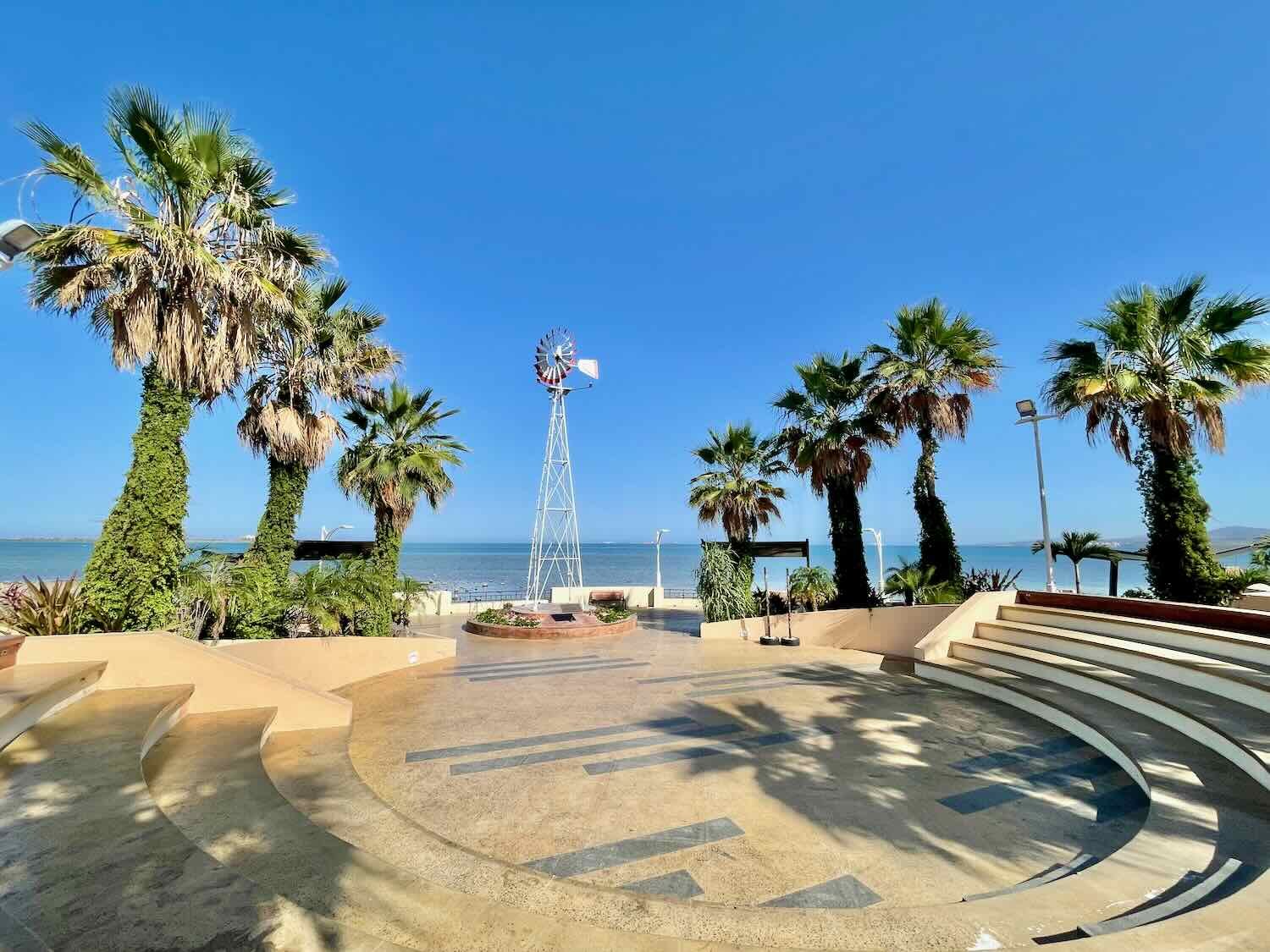
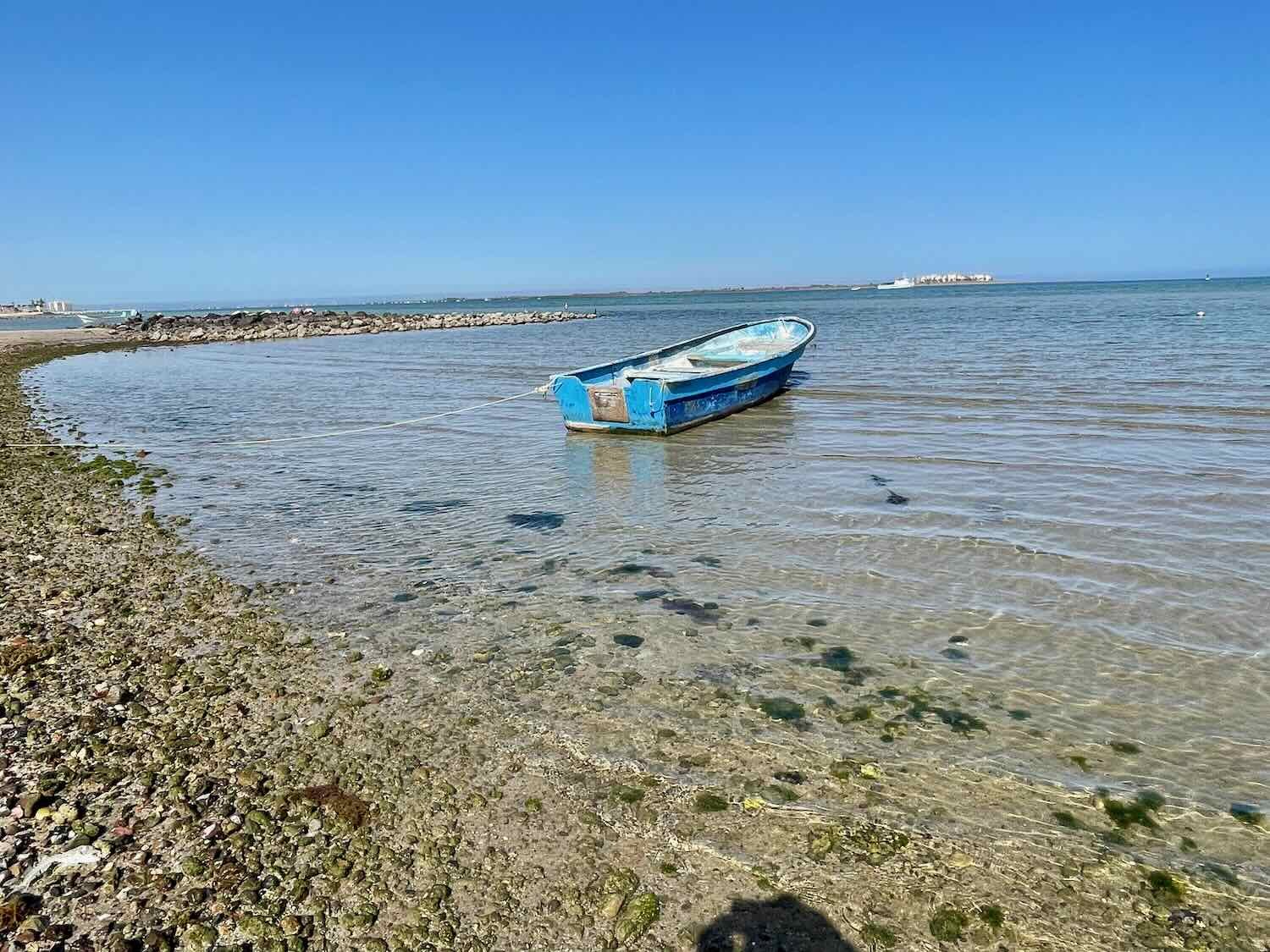
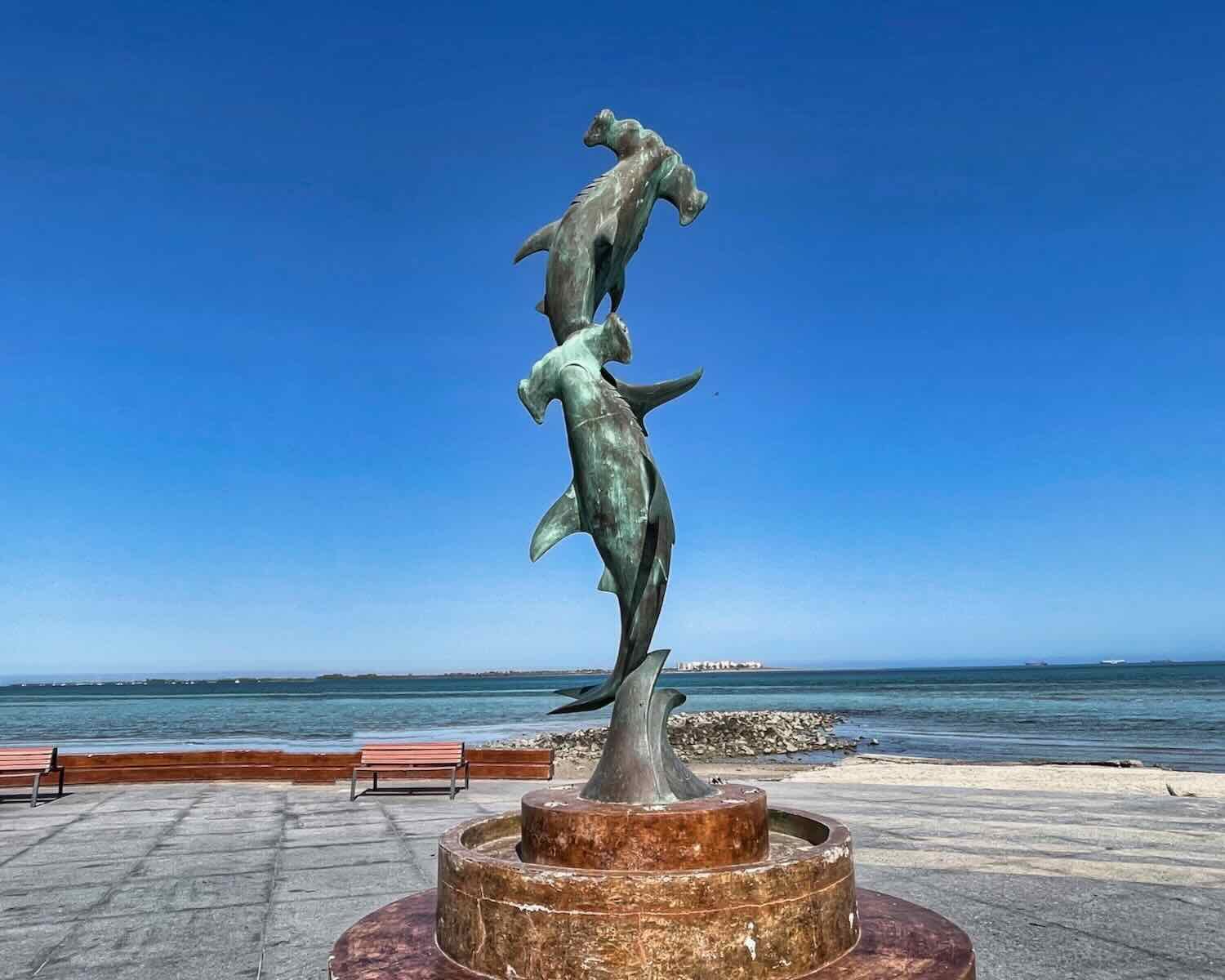

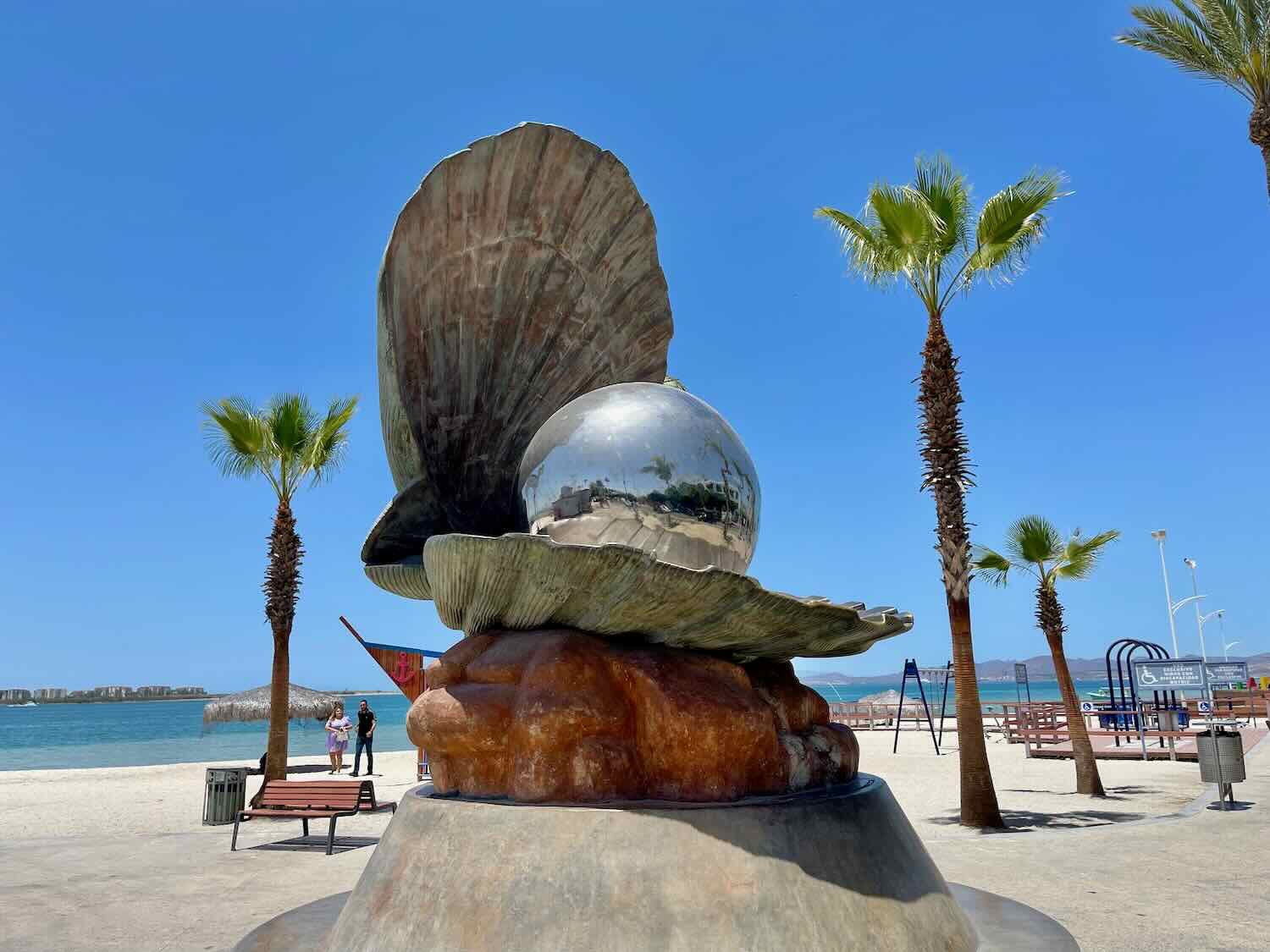
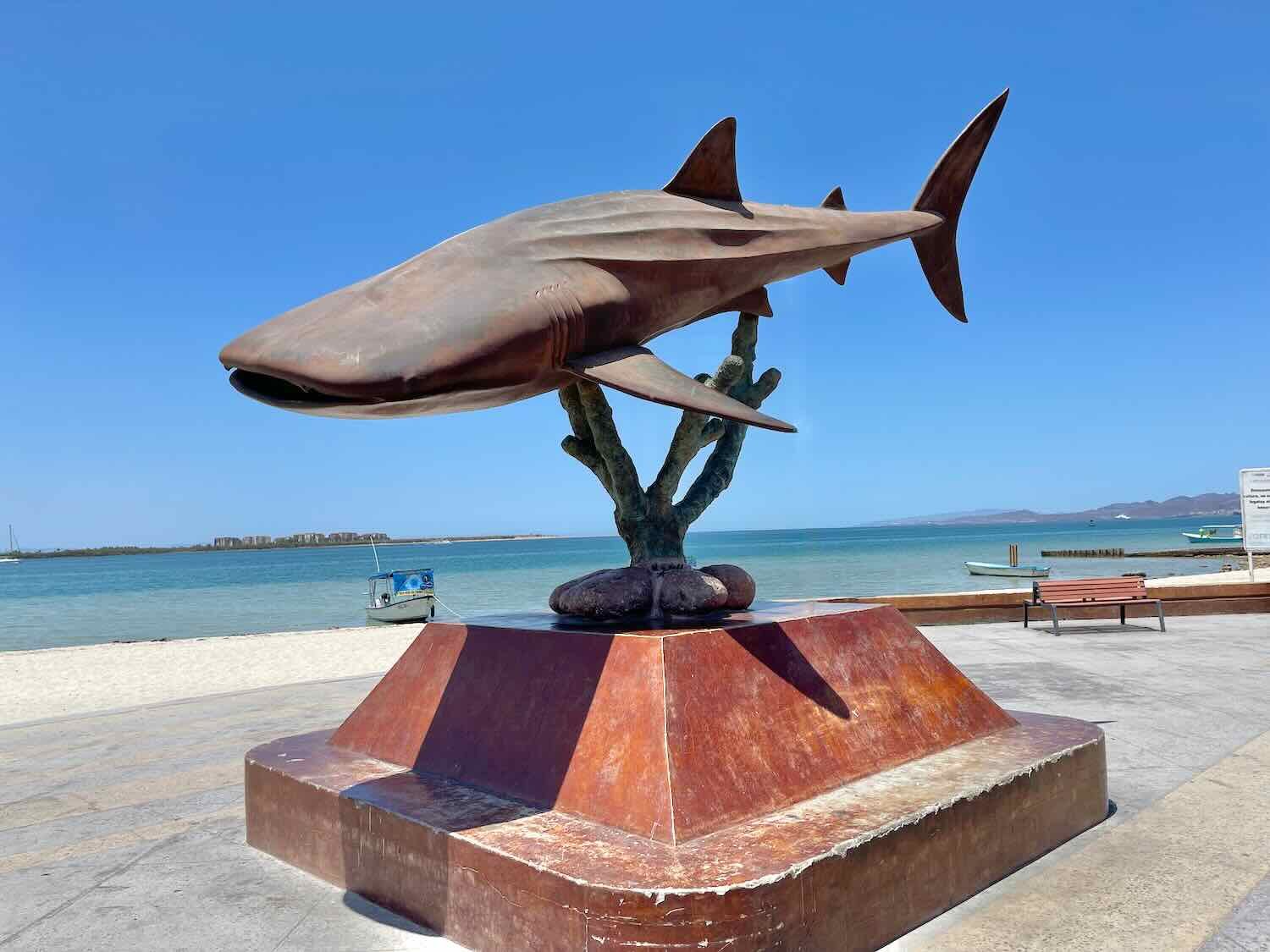
The Catedral de Nuestra Señora de La Paz is one of the mission churches established by the Catholic missionaries in colonial Baja. Its pale pink stone, quarried from mountains we had ridden past that lie to the north of the city, appears luminous in the evening light. La Paz, Baja California Sur, Mexico. Copyright © 2019-2023 Pedals and Puffins.
Across the city’s main plaza from the Cathedral lies the handsome, white colonial building of the La Paz Museum of Art.
As in many Mexican cities, playful and evocative murals have been painted on the sides of quite a few buildings.
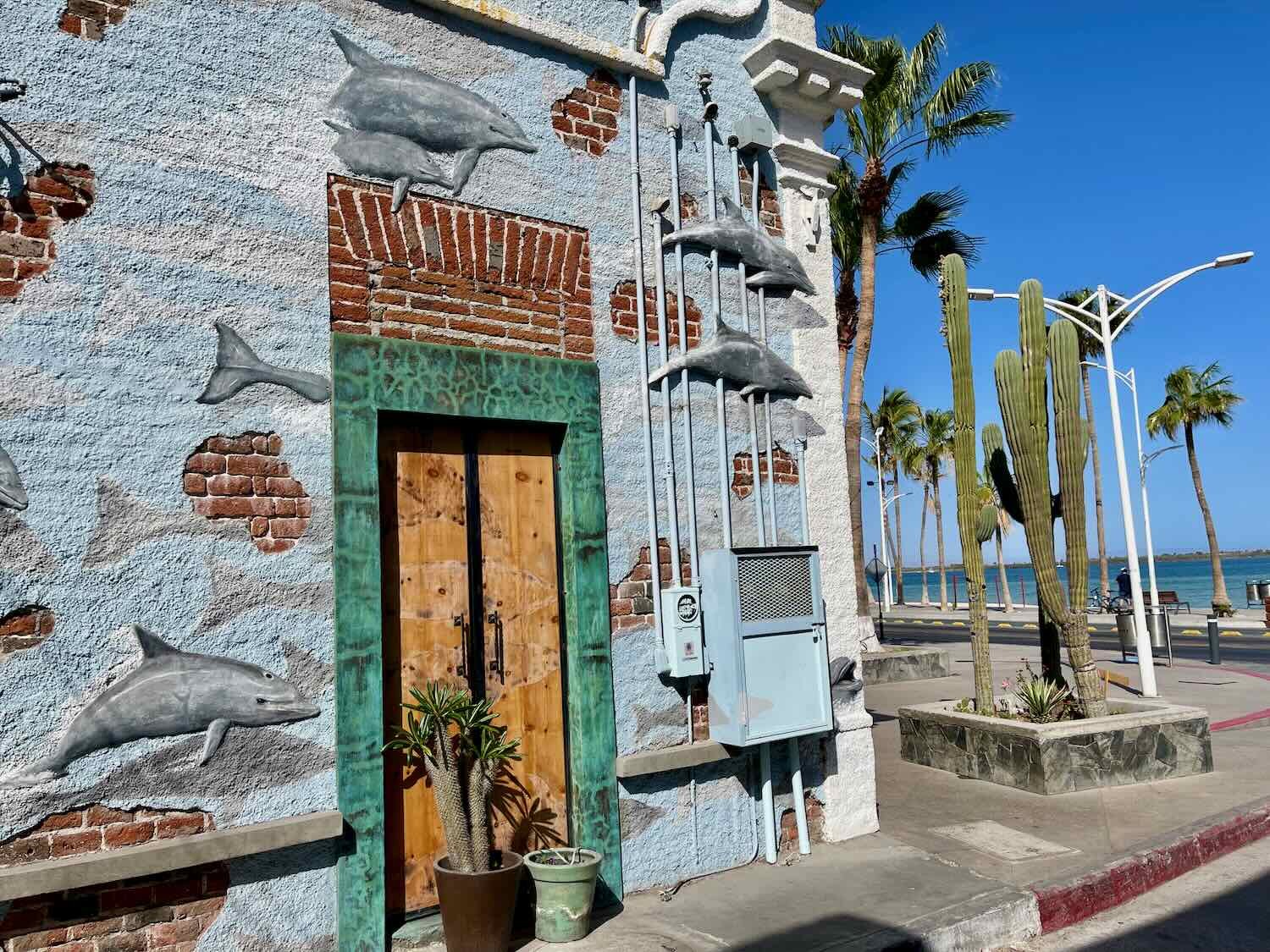
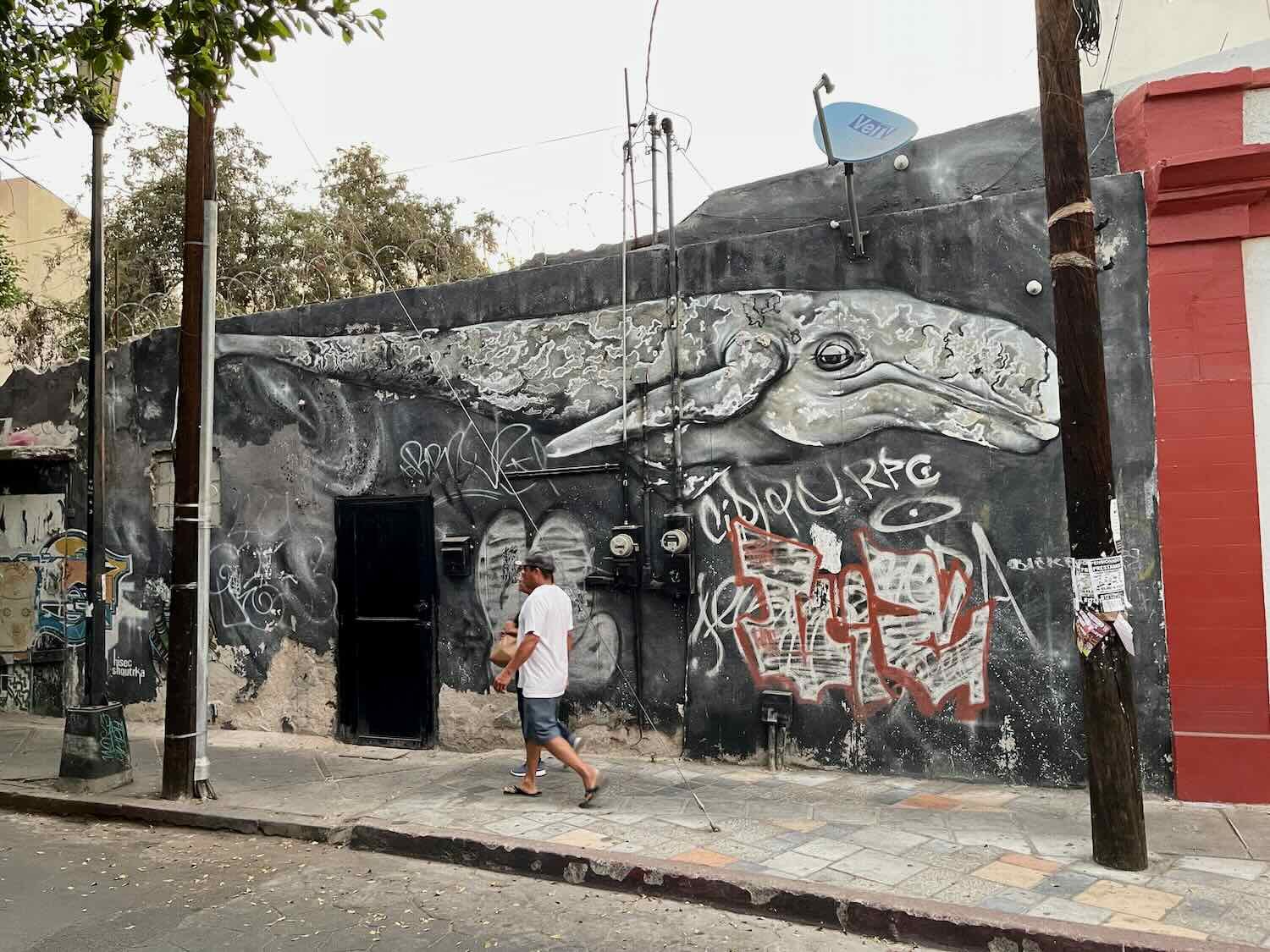
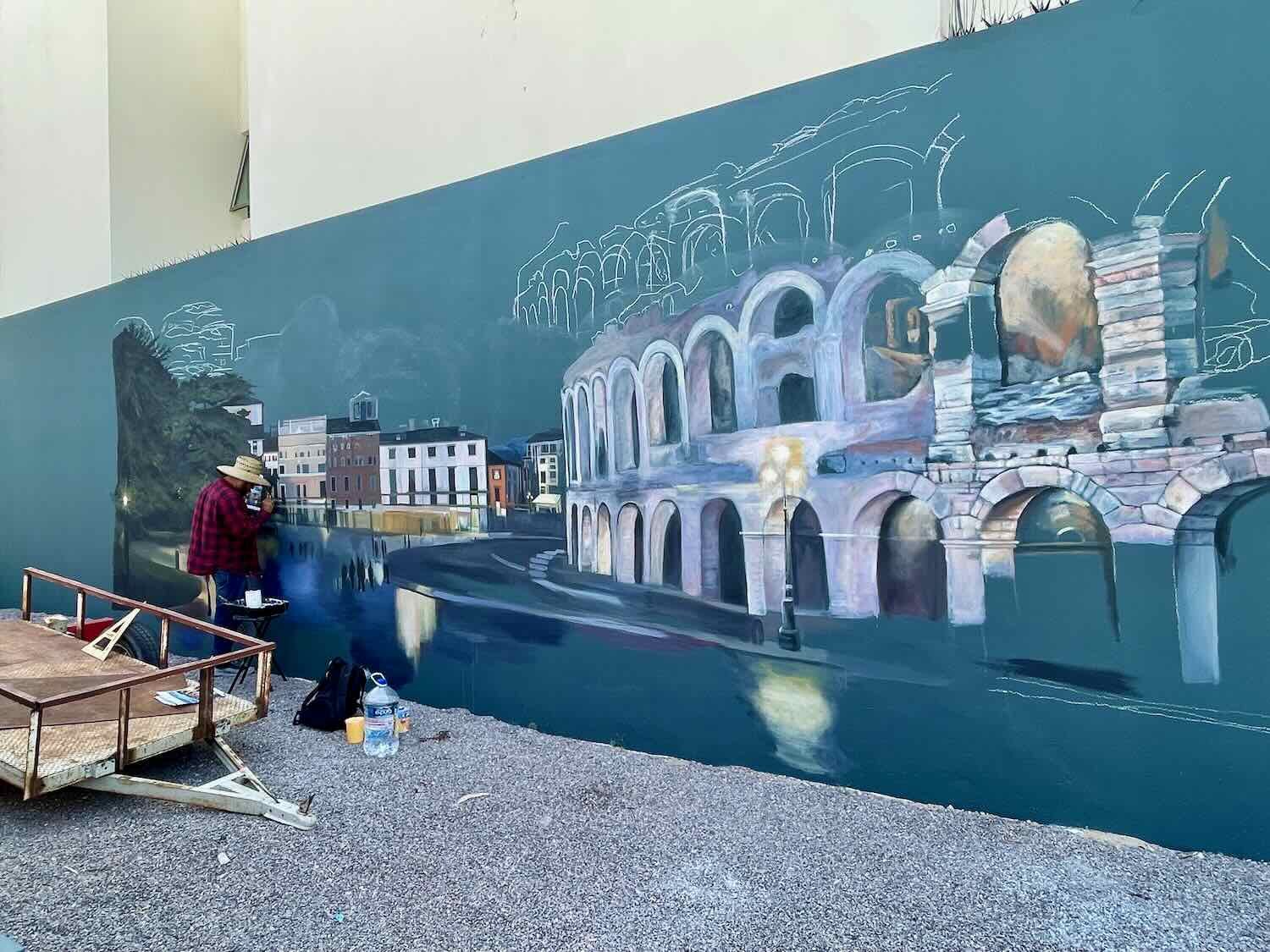
Farewell to the Baja Divide
There is no denying it, the Baja Divide is challenging. Many cyclists just head down the only paved highway that runs the length of Baja (Hwy1). But in doing so, they miss some of the wildest and most rugged parts of a truly fascinating landscape. It took us three months (with 11 days off for dentist visits plus an extended break during Easter), at least 50 days more than if we had taken Hwy 1, but we finally reached the end of the Baja Divide. We’ve had to overcome rocks, sand, wind, mud, freezing nights, baking-hot afternoons, bee stings, limited water, mind-bogglingly steep hills (both up and down), bicycle crashes, cactus spines, multiple dentist visits, broken equipment, crowing chickens, countless water crossings, and we lost a few items along the trail. All of these things tested our physical strength and mental toughness, as well as our ability to adapt, plan, use good judgement and work as a team.
But we were rewarded with awesome sunsets, breathtaking mountains, panoramic canyons, tranquil seas, bursting sea-spouts, picture-perfect campsites, quaint and colorful towns, and most of all, the warm, deep and genuine hospitality of Baja’s people. The benefit from such experiences often takes time and reflection to reveal itself, but we couldn’t have asked for a better, more eventful and challenging way to spend our days. Baja will always hold a special place in our hearts.
We made it! The end of the trail on the Baja Divide. La Paz, Baja California Sur, Mexico. Copyright © 2019-2023 Pedals and Puffins.
Sunset over the Bay of La Paz. Malecón, La Paz, Baja California Sur, Mexico Copyright © 2019-2023 Pedals and Puffins.
From here we plan to take the ferry from La Paz to Mazatlán on the mainland of Mexico, where we will continue our journey south.

